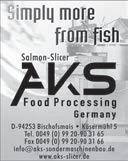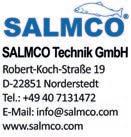


























































































Immerse yourself in three days of networking, education and business growth opportunities at Seafood Expo Global/Seafood Processing Global. Discover the latest innovations in seafood products, processing equipment and services from suppliers from around the world.
According to 2024 visitors:
say the Expo is of importance to their business 87% plan to return in 2025
of visitors who were looking to place an order/appoint a supplier achieved their goals
Register today with promo code EUROFISHDEC24 to secure the lowest possible rates!
Online: seafoodexpo.com/global/reg Tel: +31 88 205 7200
Interested in showcasing your products or services to a global seafood audience? Contact the team at sales-global@seafoodexpo.com










e Italian shery for deep-water red shrimps is highly valuable and particularly important for the Sicilian port of Mazara del Vallo where most of the bottom-trawling eet that targets these species is based. e high value that these shrimps command led to indiscriminate shing and declining catch rates for decades and in 2022 restrictions were introduced under multiannual management plans. During the plans’ rst phase scientists will gather information about the stocks that will then inform a long-term management plan to run from 2026-2030. Read more about an Italian shrimp shing and processing company’s response to the restrictions on page 26
Italian vessel owners and shing companies with vessels active beyond 12 nautical miles are organised in Federpesca, a body that provides legal and technical support to its members. is eet segment has seen many changes as new regulations that reduce shing opportunities have resulted in fewer vessels and changes to shing gear both of which have had an impact on pro tability. Another issue is the lack of a level playing eld as vessels from di erent countries around the Mediterranean compete for the same resources but must comply with di erent regulations. Read more on page 24
e impact of light on the growth and wellbeing of sh and other aquatic creatures grown in captivity is a relatively new area of study. Trials have shown that light of certain wavelengths can be bene cial to growth. An Italian company is developing sophisticated lighting systems that mimic natural light for use in aquariums and hatcheries to further optimise conditions for their inhabitants. e systems allow the wavelength and photoperiod to be tailored to the species to enhance physiological and chemical processes. Read more on page 28
As countries strive to decarbonise their economies, the aquaculture sector, although responsible for only a small fraction of emissions, is also expected to contribute to this e ort. e sector uses electricity to power equipment as well as fossil fuel for transport and logistics on land and in the water. Some of these electricity needs could be met from renewables, while fossil fuels could be replaced with electrical, hybrid, or biobased alternatives. Solar panels and hydroelectric solutions are already being deployed, but these changes need to become more widespread before they start to make a di erence. Read more on page 34
As the Italian Fish Farmers’ Association (API) adjusts to the fallout from the pandemic, the war in Ukraine, high in ation, as well as the continuing e ects of climate change, it must also ensure an economically, environmentally, and socially sustainable aquaculture sector. Matteo Leonardi the newish president of API discusses the challenges of re ghting while simultaneously implementing strategic measures to secure the future of the industry. ese initiatives include working more closely with government authorities to streamline the processes that currently impede the launch or expansion of aquaculture operations. Read more on page 35
A Spanish technological organisation is harnessing arti cial intelligence, smart sensors, the internet, and risk prediction models into a system to monitor sh cages for potential failures. e system will enable operators to act before problems become critical. Intended for sh farms o shore, where environmental conditions are often unforgiving, the system monitors cage infrastructure for a range of parameters. Unlike manual monitoring which often identi es an issue only after considerable damage has occurred, the system anticipates weaknesses in time. Read more on page 37
A project in Spain has developed a novel use for old shing nets—road construction. Researchers at the University of Salamanca with other partners have found that old or discarded shing nets made from certain materials can be shredded and added to asphalt to make roads that are stronger and more durable than conventional roads. e discovery should help with another problem, that of abandoned, lost, or discarded nets as shers would have an incentive to bring in their old nets to be recycled which in turn could reduce the incidence of ghost shing. Read more on page 39
Asia is the centre of the live seafood trade, an industry the value of which can only be guessed due to its diversity and a lack of accurate data. It is a lucrative business for some of the links in the supply chain but is associated with environmental destruction, poor animal welfare, the introduction of alien species, and the spread of pathogens. Monitoring and control systems are not up to the task of regulating this activity in many of the countries involved and while measures such as catch quotas, export controls, and prohibitions on shing certain species have reduced the trade they have not eliminated it. Read Dr Manfred Klinkhardt’s article from page 45
Researchers at a UK engineering company focused on conservation discovered that the lights developed to attract crabs and lobsters into pots were also irresistible for scallops. e discovery resulted in the modi cation of crab and lobster pots to catch scallops by equipping the pots with strategically placed LED lights. Trials showed that the pots work and today over 40 shing vessels use them. A big advantage of the pots is that they are environmentally benign, while traditionally scallops are caught by dredging. Read more on page 50
6 International News
8 Eurofish Member Country National Pavilions at Seg/Spg 2025
10 Nordic Marine Think Tank, ICES climate change forum, January 2025, Helsingborg Eating for the environment
15 Wildlife resources will remain indispensable for the foreseeable future
Encouraging success in eel reproduction
21 VeriFish is developing an effective sustainability indicator framework for consumer information
Credible information on food’s sustainability
24 Federpesca committed to economically and environmentally viable fisheries
Seeking a level playing field in the Mediterranean Sea
26 Rosso di Mazara: A tradition of excellence in Mediterranean seafood High-value shrimp products for global markets
28 GNC Bluray offers LED lighting solutions for aquaculture and other applications The right light gives healthier fish
30 AquaFarm 2025, 12-13 February, Pordenone A challenging period for bivalve farmers
34 Fish and shellfish farming have several paths that lead to carbon neutrality
Decarbonising the EU aquaculture sector
35 Italian fish farmers’ association addresses crises while future proofing the sector
New president has his work cut out
37 DigiSafeCage—A digital revolution unfolds in the fish farming sector
Securing the future of offshore aquaculture


















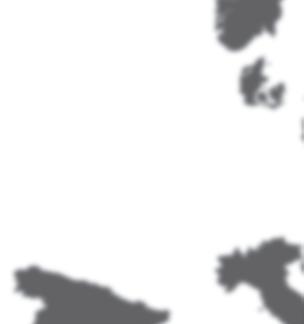


































































39 A Spanish project, RheoNet, mixes worn-down nets with asphalt to make durable roads
From sea to road—repurposing fishing nets
42 Hamachi, kanpachi, and hiramasa
Ideal for sushi, sashimi, and other preparations













































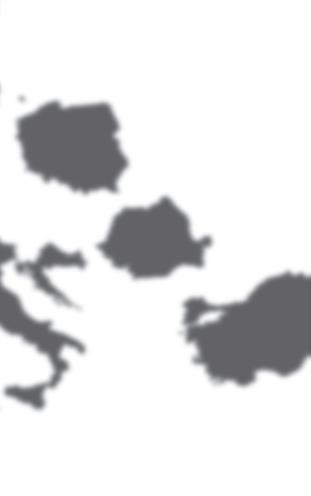
45 Attractive profits from trading in live fish
Live fish trade endangers marine ecosystems
Technology
50 A chance discovery leads to an environmentally benign way to target scallops LED lights prove irresistible
52 Ukraine’s fisheries and aquaculture sector: Impacts of Russia’s war against Ukraine Resilient waters of Ukraine
55 Neither environmental, economic, nor social considerations can be neglected Balancing competing needs is critical
57 Diary Dates
58 Imprint, List of Advertisers

Scan the QR code to access the Eurofish Magazine website (www.eurofishmagazine. com), where you can also sign up to receive the Eurofish Magazine newsletter.

Seafood lovers in Spain’s Mediterranean province of Valencia look for the usual attributes of fish, including meat with as few bones as possible, delicious taste, plenty of nutrition, and convenient product packaging. But the most important characteristic they value is freshness, and they are willing to pay extra for that, according to a new study of consumers in Valencia by researchers associated with the Ainia Technology Centre and the province’s government department overseeing fisheries. The report, Study to improve the marketing of fish, is being promoted by the Department of Agriculture, Water, Livestock and Fisheries of the Generalitat Valenciana, which commissioned Ainia to carry out the survey. The goal was to learn the preferences and purchasing patterns of at-home consumers of fish, to help guide seafood
producers and processors in providing the best products.
It turns out that local species are not always those in highest demand, but they still can be processed and marketed to consumers. The most sought-after species include salmon, tuna, hake/ whiting, sea bream, sea bass, and swordfish. All of these and other species are preferred by consumers when in retail packaging that is environmentally friendly (reusable or recyclable containers, for example). Boneless (or nearly so) fish is desirable because of the added convenience; fish with numerous hard-to-remove bones turn consumers away. All fish have some health benefits, but some are healthier than others. Finally, the fish must be affordable enough to be eaten at home on a regular basis in households on working class incomes. But the first thing a

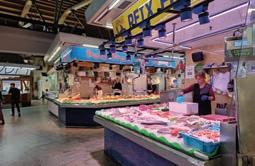
Consumers claim to prioritise freshness over price when buying fish, yet in reality, their purchasing decisions are largely driven by cost.
seafood consumer looks for, more than recyclable containers or low fat content, is freshness. More than any other protein source, fish is examined very carefully by consumers for the “catch of the day.” No time can be wasted in moving fish from the dock (or for imported fish, the truck) to the kitchen. The
lessons about packaging, etc., are relevant to less preferred species too, and consumer lack of knowledge about them can be addressed with recipes, species abundance calendars, and other educational tools. All this information can help get the right seafood product to the right consumers.
17-18 June 2025
Swissôtel Tallinn, Estonia

Sessions will include: Invasive species - an overview in Europe Predators - turning threats into opportunities Business opportunities in freshwater and saltwater areas



Fisheries in Danish waters are in poor shape. Aside from weak markets for fish and rising costs for inputs that all of Europe’s fishermen face, Danish fisheries are producing less fish because the marine environment is suffering. One of the many causes of environmental habitat damage is nearshore bottom trawling, which upsets the spawning grounds for the very species the trawlers are having difficulty catching, such as cod. To help solve this problem, the Danish government has proposed a restriction on bottom trawling in certain areas where fish nurseries are known to occur as well as near protected areas such as Natura 2000 shared with Sweden.
For example, the existing restricted area would be joined with a ban on bottom trawling in the Øresund and Køge Bay; a ban in the eastern Kattegat, following the maritime border with Sweden from Læsø to Anholt and covering the existing
habitat areas, Kims Top and the Great Wall. With large, continuous areas with a trawl ban, stated Environment Minister Magnus Heunicke, we give the seabed, the benthic animals and thus the entire ecosystem with fish, porpoises, etc. in the sea much better conditions to recover. Together with our plan to reduce nitrogen emissions and the work to restore marine nature, more trawl-free areas will help correct the catastrophic course that our marine environment has been on for far too many years.
In addition to spawning grounds, bottom trawlers upset the food supply not only of cod but all fish, birds, marine mammals, and other marine life, offsetting the entire ecosystem in Danish waters. Magnus Heunicke explained that one of the major pressure factors on the food base of cod, porpoise, eider, and other species is fishing with bottom-trawling gear, which
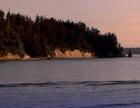
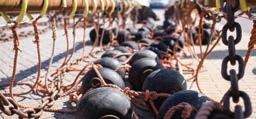
Rockhoppers are used in bottom trawling to help fishing nets navigate rough sea bottoms. They cause damage by crushing seabed organisms and altering marine habitats. The movement of rockhoppers stirs up seabed sediments, potentially releasing stored carbon and contributing to marine CO2 emissions.
is dragged across the seabed. In just one trawl haul in the soft mud bottom of the Kattegat, around 12 percent of the existing benthic animals die, which are of crucial importance to the food chain and the overall ecosystem in Denmark’s waters. The vulnerable areas designated in the announced proposal were specifically chosen to minimise this damage. Fishing faces
a number of challenges, and a new course is needed, said Jacob Jensen, Denmark’s fisheries minister. Balanced fishing must take responsibility for a healthy marine environment and sustainable fish stocks, while at the same time offering the best conditions to be able to develop and adapt to the green transition, so that the country also has a strong fishery in the future.
29th International Fisheries Exhibition Aalborg, Denmark 07-09 October 2025
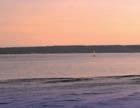

One of the most important exhibitions in the world focused on commercial fishing and the wider maritime sector.
•Marine equipment, fishing gear, maintenance, machinery, navigation etc.
•400 exhibitors from 30 countries
•12,000 international visitors
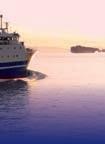

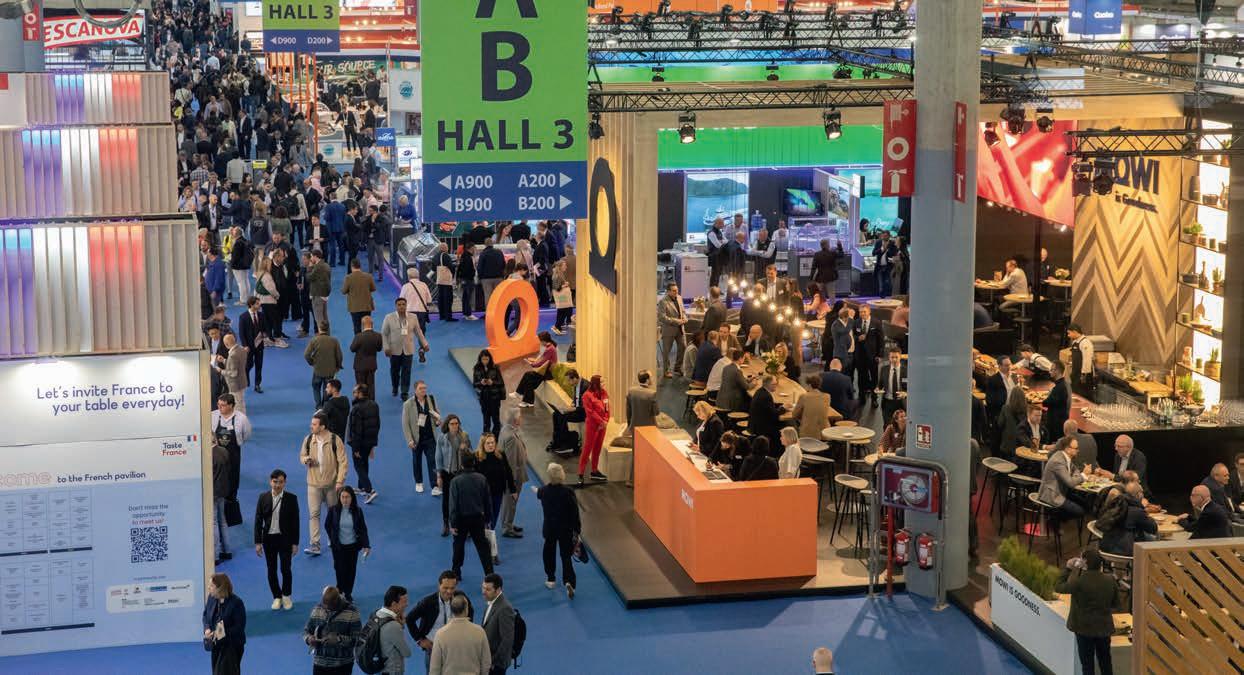


4G501 LITHUANIA* 2A203 SPAIN 4E301, 4E401, 4F401, 4F301, 2G401, 4E200, 2G501, 2H401, 2H501 TÜRKIYE 2B601, 2B701, 2C601, 2D601, 2D701
2E400, 2E401, 2E500, 2E501, 2E600, 2F401, 2F501, 3FF601, 3GG601, 5F600, 5G501
The Nordic Marine Think Tank and ICES organised the third Nordic climate change forum for aquaculture and fisheries in Helsingborg. This edition looked at how food choices affect emissions and how consumers can choose to eat in a way that benefits both themselves and the planet.
The Nordic Marine Think Tank (NMTT) is a network that brings together fisheries experts from the Nordic region. Its purpose is to support better public decision making and the sustainable exploitation of marine living resources by drawing on Nordic skills, experience, and solutions. Together with ICES, the International Council for the Exploration of the Seas, NMTT organises a climate change conference for aquaculture and fisheries. The events were held in 2021, 2023, and most recently in January 2025.
Organised in Helsingborg, Sweden, the 2025 edition was moderated by Carl-Christian Schmidt, formerly at the OECD and now a board member of the NMTT. The purpose of the event was to understand how policies and measures, for instance labelling or information campaigns, can shift consumers towards more climate friendly food choices. It also sought to better understand the role of private companies along the seafood value chain in educating consumers about the climate impact of the food they eat.
In the opening intervention, David Reid, Chair of the ICES Science Committee, provided some useful background on some of the impacts of climate change
including, rising global temperatures, changes in ocean pH and acidification, decreasing ocean oxygen levels, marine heatwaves, rising sea levels, shifts in Arctic ice melt, and ocean CO2 absorption, and how they affect fish migration patterns, growth rates, and population distribution, fundamentally altering how fisheries operate which in turn has an impact on fisheries supply chains. Fish stocks, he said, are shifting their spatial distribution due to water temperature, salinity, and oxygen changes. As ocean temperatures rise, fish move toward cooler waters, either northward or into deeper regions. However, this shift isn’t simply a direct response to temperature. Other ecological factors like food availability and ecosystem changes also play a role.
He pointed out that some fish species are moving northward, while others are moving southward, demonstrating a complex reaction to climate change. Moreover, a meta-analysis of European fisheries shows relatively stable fish distributions, except for certain species increasing in northern waters. Additionally, a study of the North American Atlantic coast found a change in fish locations after 2010, coinciding with a 1°C increase in sea surface temperatures but the shift was not uniformly northwards for all the species studied—some moved in a southern direction. The point, he emphasised, was that shifts in stock distribution cannot
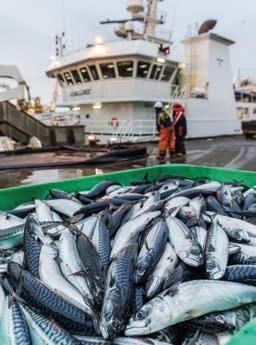
Small pelagic fish like mackerel have lower climate intensities than pork, chicken, or eggs. Moreover, they are both tasty and healthful.
purely be attributed to higher temperatures but rather to a changing ecosystem.
As fish experience higher water temperatures, their growth rates, maigration patterns, and reproductive cycles also change. Studies show that spawning takes place earlier as the temperature increases with the result that eggs, larvae, and young fish must
contend with different conditions in the sea in relation to the feed they prey on as well as to water currents which affect larval dispersion. Warmer water leads to faster juvenile growth, but the young fish use more energy in the process and will reach smaller adult sizes. Fishing smaller adults means that greater numbers are taken per tonne of fish, to which, over time,
the fish respond by maturing earlier. This slows their growth and decreases their fecundity as smaller fish produce fewer as well as smaller and less viable eggs. These changes are complex and have spillover effects that have real world implications for fishers and fisheries policymakers. Fisheries management needs to adapt to a more fluid environment with fluctuating productivity and shifting population boundaries.
Fishing also has an impact on the biological carbon pump, the processes that capture carbon from the sea surface and sequester
it in deep waters. Phytoplankton absorb CO2 from the atmosphere, which is then consumed by zooplankton and fish. Some of this carbon is returned to the atmosphere through respiration, but a significant portion sinks to the deep ocean via faecal matter and dead organisms helping to store carbon and mitigate climate change. Mesopelagic fish (living at 200-500m depth) play a critical role, contributing to 35 of deepsea carbon sequestration. Overfishing these species could significantly disrupt the ocean’s ability to store carbon, raising concerns over plans to exploit mesopelagic fish stocks. Macrozooplankton (krill) and mesozooplankton (copepods) are responsible for a further 45 of carbon storage.
One of the most controversial issues in fisheries is the impact of bottom trawling on carbon release, Dr Reid said. A 2021 study claiming bottom trawling releases as much carbon as global air travel, sparked intense debate. However, he referred to subsequent reviews that found 61 of studies showed no significant carbon release, while some even showed increased carbon storage due to seabed disturbance. This suggests that fishing’s impact on seabed carbon is a field that still needs in-depth research and varies by location, requiring targeted
spatial management strategies rather than blanket bans. Fuel use in fisheries has steadily increased despite stable or declining catches. This is because depleted fish stocks require more effort to harvest. A more fuelefficient fleet and better fishing gear design could reduce emissions. Reducing seabed contact in trawl fishing could create a win-win scenario, lowering both fuel consumption and habitat damage. And restoring fish stocks to sustainable levels would improve catch efficiency, further reducing emissions.
Concluding his presentation, Dr Reid pointed to the major policy challenges for fisheries management created by climate
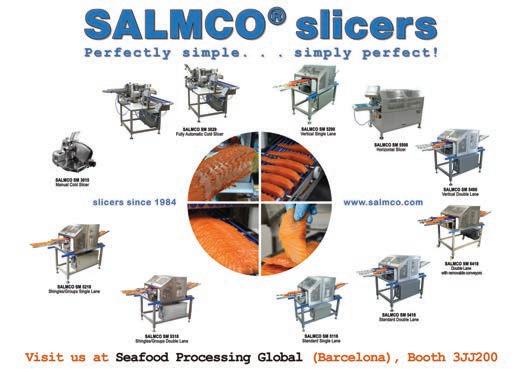
Seafish, UK
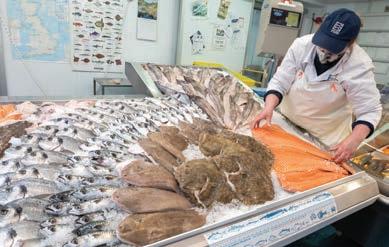
change. The overlapping effects of temperature, productivity changes, fish migration, and carbon cycling make decisionmaking complex. Potential policy solutions include, spatial fisheries management (protecting high-carbon storage areas from excessive fishing, decreasing the contact with the sea bottom, and fishing in low carbon storage areas); ecosystem-based fisheries management (integrating carbon sequestration considerations into fisheries policy); encouraging lower-carbon fisheries (promoting fuel-efficient gear and alternative fuels); and adaptive quota systems (allowing fishing rights to shift as fish populations migrate).
Continuing the theme of the impact human behaviour has on climate, Prof. Elinor Hallström from the Technical University of Denmark’s National Food Institute (DTU Food), reported on the influence of diet on climate,
particularly in Nordic countries, with a focus on seafood consumption. She highlighted how the food system significantly contributes to environmental pressure, accounting for about one-third of global greenhouse gas emissions and consuming vast natural resources. From a health perspective, the global population faces a dual challenge: around 10 suffer from food insecurity, while 40 struggle with overweight and obesity. This imbalance underscores the urgent need for sustainable diets.
Research estimates that the climate impact of Swedish diets is approximately two tonnes of CO2 equivalents per person per year, a figure mirrored in other Nordic countries like Denmark and Iceland. These numbers significantly exceed suggested planetary boundaries for sustainable food systems. Seafood’s contribution to dietary climate impact is relatively small, ranging from 4 in Sweden to 6 in Denmark and between 4–11 in Iceland. Among
300 and 450 g/week. Meanwhile, red meat consumption exceeds health recommendations, especially among men, sometimes by two- to threefold. Shifting diets toward increased seafood consumption and reduced red meat intake offers both health and climate benefits. Research shows that fish eaters who omit meat may have a dietary climate impact nearly 50 lower than heavy meat consumers. Studies also indicate that replacing meat with fish can reduce dietary climate impact by an average of 47.
Swedish adolescents, seafood accounts for only 3 of dietary climate impact, compared to 9 in older adults. However, seafood’s environmental footprint varies widely by species and production methods. Studies show that small pelagic fish, bivalves, and species like Alaska pollock and pink salmon have lower climate intensities than pork, chicken, or eggs. In contrast, wild-caught crustaceans, cephalopods, and some farmed white fish can have climate footprints comparable to pork or beef per edible weight.
Consumption of red meat exceeds and of seafood falls short of recommendations
From a health perspective, seafood consumption is beneficial at all life stages. Current intake in Nordic countries varies from 30–80 grams per person daily, with Norway showing the highest consumption. However, most countries fall short of recommended levels of 43-64 g/d or between
Despite the potential benefits of dietary shifts, Prof. Hallström reported that data limitations pose challenges. Many findings rely on self-reported dietary data, which can be unreliable due to misreporting and a lack of detailed information on seafood species consumed. Additionally, most environmental impact assessments focus on climate effects, often overlooking critical sustainability concerns such as overfishing and biodiversity loss, she said. There is a pressing need to develop comprehensive sustainability indicators to better assess seafood’s overall environmental impact.
Prof. Hallström concluded by noting that the climate impact of Nordic diets far exceeds sustainable limits, with seafood contributing only a small portion to total emissions. However, seafood consumption is currently too low for optimal health, while red meat intake is excessive. Substituting red meat with sustainably produced seafood presents a promising strategy for reducing dietary emissions while improving public health. Finally, she pointed out that better data collection and sustainability assessments are necessary to guide informed dietary transitions.

Voluntarily adjusting one’s diet to resemble those described in official recommendations would lead to better outcomes for an individual’s health as well as for the planet. However, we see very little of such spontaneous changes. Instead, policies, such as those


governing taxes and subsidies could also induce consumers to shift their food consumption in a healthier and more sustainable direction, reported Jörgen Larsson, a senior researcher at Chalmers University of Technology in Gothenburg, Sweden. His intervention focused on two key aspects of taxes and subsidies: their impact on consumption levels and their acceptability among voters and politicians. He argued
that while food choices are personal, they also have significant societal implications, particularly regarding public health, economic productivity, and climate change.
Rising obesity rates, especially among young people, are a major concern in Sweden and other countries. Since children cannot always make informed dietary
a role in shaping healthier food environments. Additionally, poor dietary habits increase healthcare costs and reduce workforce productivity, while the environmental impact of food production, particularly meat consumption, is substantial—nearly double that of all passenger car traffic in Sweden. A previous report identified 17 different policy measures to promote healthier and more sustainable eating habits. Existing strategies, such as dietary guidelines and voluntary food labelling, are useful but insufficient. Stronger interventions include marketing regulations, for instance, promotional discounts (e.g., «buy three, pay for two») for unhealthy foods are banned in the UK; and food taxes and subsidies. These are widely used in transportation, but applying similar measures to food has faced resistance.
The effectiveness of pricing strategies in shaping consumption patterns is evident. For instance, when Sweden joined the EU in the 1990s, beef prices were cut in half, leading to a 50 increase in consumption and thus highlighting the price sensitivity of food choices.

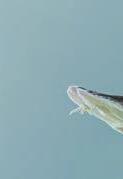
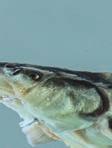
Sponsoring the World Caviar Forum 2025 in Barcelona





Fast growth and healthy uniform fish
Highly digestible raw materials
Feed for the entire production circle for pond and RAS


Preferred high-quality feed around the world








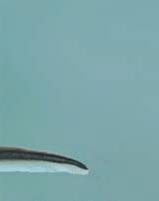







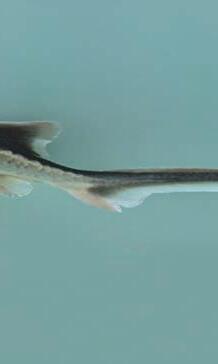

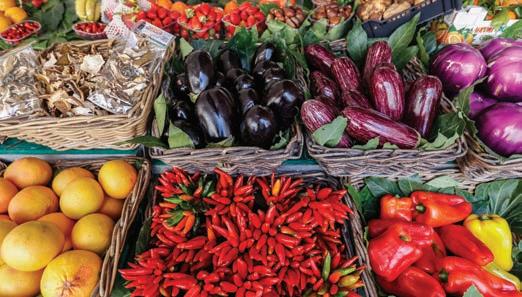
experts from the Karolinska Institute, the Swedish University of Agricultural Sciences, and Chalmers University of Technology— proposed a cost-neutral food tax shift. This means increasing taxes on certain foods while lowering them on others, ensuring that the overall food budget for consumers remains unchanged. Key principles guiding the reform are that taxes should be based on robust scientific evidence of health and climate effects; policies should minimise administrative costs by categorising food products broadly; and equity concerns should be addressed, as low-income groups spend a larger share of their budget on food.
The study relied on unique data which was collected from
Sweden’s largest food retailer, ICA, and included extensive sales and pricing figures. Price sensitivity (elasticity) was measured across various food categories. Findings showed that a 1 increase in meat prices typically led to a 0.7 drop in consumption. Additionally, the study analysed 13 different tax reform scenarios, but one model stood out as particularly effective and feasible: the Integrated Tax Shift Using Subsidies. This model predicted that excise taxes of SEK31/kg on beef and lamb (based on the carbon footprint) would result in a 19 drop in consumption and an excise rate of SEK5.4/kg on pork would deliver a 0.7 decline in pork consumption. Moreover, removing VAT (12 on food) altogether on wholegrain products, consumption increased 7-18. Consumption of fruits, vegetables, and legumes increased 4.4 when VAT was removed. The
model also predicted that a tax of SEK3.7/litre on sugary beverages would shrink consumption 24.
Using a model from the WHO, the researchers also established that the food tax reform would result in 700 fewer premature deaths per year—in comparison 230 people die each year in traffic incidents. The tax reform also reduces the climate impact by 4.4 corresponding to an 8 reduction in emissions from Swedish passenger cars. Dr Larsson also assumed that food manufacturers would respond to the food tax shift by changing their recipes (e.g. reducing sugar content in soft drinks) and their marketing (e.g. increased advertising of bread from which VAT has been removed). The state benefits too in the long run, he proposed, from lower medical costs, less time off due to illness, and fewer environmental costs. In
conclusion, he said this model of the food tax reform (one of several that were studied) offers a practical way to improve public health and sustainability without raising food prices overall. For further reading visit www. matskatteväxling.se (in Swedish), scientific articles on impacts (https://papers.ssrn.com/sol3/ papers.cfm?abstract_id=5065746) and acceptability (https:// papers.ssrn.com/sol3/papers. cfm?abstract_id=5065746).
The impacts of climate change on fish stocks are complex but efforts to mitigate them including by encouraging more climatefriendly food choices should be taken seriously. The NMTT-ICES workshop featured several interesting and informative interventions which are freely available at https://www.nmtt.org/_files/ ugd/ec7f32_6711ee8f3f3045e58676 8631dee8018f.pdf
Wildlife resources will remain indispensable for the foreseeable future
In Germany, the European eel ( Anguilla anguilla ) has been declared Fish of the Year 2025. This is an appropriate and useful choice, as it draws more public attention to this fish. Eels have long been an important subject for fish research. The research is primarily concerned with the reproduction of these fish to help conserve the species. What is the current state of research in this area?
The family of freshwater eels (Anguillidae) is the most economically important of the 16 families of the Anguilloidei (eel-like) suborder. It contains only one genus, Anguilla, which, depending on the scientific view, comprises 16 to 18 (some authors even distinguish 20) species. The most prominent representatives
of the genus Anguilla include the European eel (A. anguilla), the Japanese eel (A. japonica) and the American eel (A. rostrata), which inhabit the east coast of North America. Regardless of their geographical distribution and finer biological details, the life histories of all eel species have striking parallels and similarities. Almost
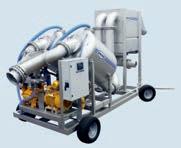
all of them migrate downstream (catadromously) at the onset of sexual maturity after spending 8–15 years (often as little as 4–5 years for males) in fresh or coastal waters and travel to their spawning grounds at sea. A characteristic feature of migrating eels is a striking change in colour and shape. Their eyes become larger,
the head gets more pointed and their intestines atrophy. During the spawning migration, eels do not feed and live off their fat reserves. Although their sexual organs are still poorly developed at this stage, a change in colour is a sign of increasing maturity: except During the spawning migration, eels do not feed and live off their
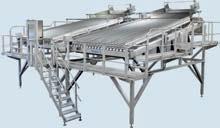




Today, a significant proportion of edible eels on international markets comes from aquaculture, which is invariably based on wildlife (capturebased aquaculture).
fat reserves. Although their sexual organs are still poorly developed at this stage, a change in colour is a sign of increasing maturity: except for their black backs, the animals are silver in colour, which explains the term silver or white eel.
Apart from a few eel specialists who conduct research in this field, that is almost all that the general public knows about the reproduction of eels. And even the experts are still baffled by this phase of life, because eels ready to spawn have never been found in nature with mature eggs or sperm. At the beginning of the 20th century, Ernst Johannes Schmidt had the idea of tracing the eel larvae (leptocephali) back in the Atlantic. As the youngest developmental stages have been found in the Sargasso Sea, it is still assumed today that the spawning grounds of the European eel are located there. Definitive evidence is still lacking because, despite persistent searches with enormous effort, neither eels ready to spawn–or at least carcasses of the animals that probably die after spawning–nor spawned eggs have been found in this vast area of sea.
This has been the case for many decades with all other eel species
in the oceans. However, shortly before the turn of the millennium, the veil was lifted for the first time when Japanese explorers, after a persistent search using a submersible, discovered the spawning grounds of the Japanese eel (A. japonica) in the western North Pacific. The area is located on the slopes of large seamounts, which eels presumably locate using their sensitive magnetic sense in the vastness of the Pacific Ocean. The importance of this discovery cannot be overestimated, as Japanese eels are a traditional part of Japanese food culture, highly valued as a food fish and have a correspondingly high market value. This is also reflected in the share of this species in global eel production in aquaculture, which has almost
always averaged 95 in recent years. By comparison, European eels only accounted for 3–4 of total production. However, these figures should be treated with caution, because the continued strong demand for eel in Japan and other Asian countries has led, and probably still leads, to the frequent substitution of other eel species for japonica in some producing countries, particularly China. In a processed form, such as kabayaki, the deception is often only noticed by connoisseurs of this delicacy.
It is therefore quite possible that the share of Japanese eels in aquaculture production is

Their amazing ability to cling and climb enables the young eels to overcome waterfalls and other obstacles when ascending river courses.
overestimated and the share of other eel species is underestimated. In particular, eel populations in Europe have suffered painful losses due to the illegal but highly lucrative smuggling of glass eels to Asia for stocking eel farms there. Even today, this black market has probably not yet been completely eradicated, despite tighter controls. The incentive for smuggling remains high because, unlike salmon, carp and other fish species with

In many regions of Europe, great efforts are made to support and maintain the eel population by stocking with glass eels and pre-grown young eels.
a completely closed life cycle, which are routinely ‘artificially’ reproduced in aquaculture, this has not yet been achieved with any eel species. Young glass eels used to stock the farms come from the wild, without exception, i.e. they are taken from wild stocks. Not just in Europe, but also elsewhere in the world. Fishing, environmental and climate change, and possibly other unknown factors, affect all eel species. For example, the catches of Anguilla japonica glass eels have declined to around one fiftieth of the previous level since the 1960s. This is why the International Union for the Conservation of Nature and Natural Resources (IUCN) has already placed this species on the Red List of threatened species as a precaution.
An important key to solving many of these problems would be human-controlled, targeted reproduction of eels. This would not only provide the stocking material for eel farms, but also allow the production of large quantities of glass eels to support natural stocks. For decades, intensive research has been carried out in several countries around the world to address this challenge.
Measured by the effort, with limited success, we are still a long way from this goal, despite occasional successes. Unfortunately, eels do not reproduce ‘voluntarily’ under artificial conditions. Their reproduction is complex and only partially understood. There is a lack of detailed knowledge of the physiological factors that are necessary for natural reproduction.
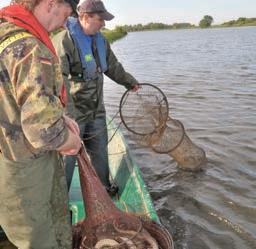
Despite the global decline in natural stocks, eels remain one of the most sought-after and valuable target species in fisheries.











































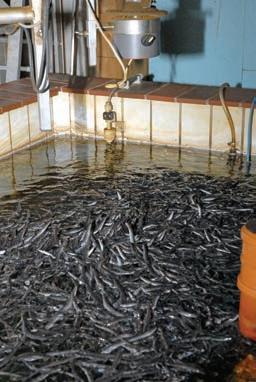
We know too little about the main stimuli caused by the migration of European eels over thousands of kilometres from freshwater to the depths of the Atlantic Ocean. However, it is well known that eels perceive environmental factors such as photoperiod and water temperature and translate them into hormonal signals that trigger the release of GnRH (gonadotropin-releasing hormone) in the hypothalamus. This sets off a cascade of hormones that ultimately leads to the maturation of the reproductive organs. GnRH acts on the pituitary gland, which subsequently releases the gonadotropic hormones FSH (follicle-stimulating hormone)
regular basis, obtaining eggs and sperm and even causing larvae to hatch. However, this is associated with high costs and can only be achieved with complex hormone treatments. The focus of such research efforts is on the five eel species: A. japonica, A. anguilla, A. dieffenbachii, A. australis and A. rostrata. They are injected with various hormonal cocktails to stimulate them to mature. Chorionic gonadotropin (hCG) is often used to mature the testes (for spermatogenesis) of the males. For females, salmon pituitary extract is used, which is particularly rich in FSH and LH. A final dose of 17α,20βdihydroxy-4-pregnen-3-one (DHP) is administered to induce final ovulation. Female European eels (A. anguilla) respond much more slowly to hormonal stimulation than females of other eel species. This usually requires at least 12 and sometimes up to 25 injections per week. Anguilla japonica only needs 9 to 12 injections, while A. australis is often ready to spawn after 6 to 8 hormone injections.
In their experiments, researchers are slowly getting closer to
the right doses of hormones. Although they also sometimes experience disappointments and setbacks, the progress of these efforts is undeniable. Successful hatching of larvae has now become almost routine for some eel species. Nevertheless, research is still a long way from achieving the goal of completely closing the eel life cycle under culture conditions. After two to three weeks, the yolk reserves are depleted and the sac fry perish. So far, it has not been possible to develop a suitable feed that is acceptable to juvenile eels and fully meets their nutritional needs. This is not due to the inability of the researchers, but mainly due to a serious problem: the extremely narrow time slot available for feeding experiments. If the offspring do not immediately accept the feed offered during the short transition to active feeding, it is practically too late. Therefore, the nutrition and development of a suitable starter food is one of the most important priorities in reproduction technology. Without such feed, there is no chance of success.
and LH (luteinising hormone). These in turn control gonadotropins and the synthesis of steroid hormones, which lead to puberty, ovulation and, ultimately, fertilisation. All this has been known for a long time, but which stimuli have to take effect and when, how sensitively the eels react to them and how they interact with the internal maturation factors has not yet been sufficiently understood.
This makes it all the more remarkable that individual research teams have already managed to stimulate the maturation of eels on a
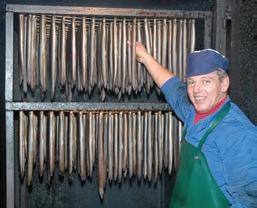
These efforts are not entirely hopeless, as there are encouraging reports of first successful results. They are again related to the Japanese eel, which is one of the most urgently studied species due to its enormous economic importance. As early as 1974, Japanese scientists succeeded in obtaining eggs with hormone injections, fertilising them and hatching larvae. In 1976, they managed to keep eel larvae for about two weeks, and in 2000, glass eels were produced for the first time. The rearing process in Japan has been perfected to such an extent that several thousand glass eels are produced every year. Nevertheless, this approach is not yet considered ready for practical use as it would be too complex and costly for aquaculture
production. For the time being, it is only suitable for laboratory use, but research is constantly being conducted on it. Not only in Japan, but also in South Korea, in 2003, eel researchers at the Foods Nutrition Research Centre of Pukyong National University succeeded in obtaining fertilised eggs from Japanese eels. The continuation of this work resulted in the first production of Japanese glass eels in 2012. And that’s not all: in 2015, the National Institute of Fisheries Science (NIFS) of the Republic of Korea even reported the successful production of 100,000 F2 eel larvae, i.e. the second generation of eel juveniles from artificially hatched and reared parents. This means that the closed life cycle of Japanese eels has been achieved under laboratory conditions.
This has also been achieved in Japan at Kindai University, which
has made a significant contribution to the aquaculture of bluefin tuna. In early 2024, larvae of eels were produced there for the first time that themselves originated from artificial incubation. Such reports naturally give hope that commercialisation of this species of eel is imminent, but researchers caution against overly high expectations. Reproduction is only possible under laboratory conditions and is not suitable for cost-effective mass production. The effort required to achieve success is incredibly high and is currently disproportionate to the result. Further research is needed. The short development time of the Japanese eel probably also contributed to this progress. For example, leptocephali of European eels turn into glass eels in about 2 to 3 years, while in Japanese eels this stage is complete after 5–10 months. And they often take just another year to fully grow

up and reach sexual maturity. For research, it is of course advantageous if the animals reach sexual maturity after only 3 or 4 years instead of after 10 to 15 years like the European eel. For this reason alone, it is unlikely that the ‘recipe for success’ of the Japanese eel can be transferred directly to European eels.
Perhaps the experiences of Asian scientists regarding the nutrition of young eel larvae and leptocephali can be utilised. The ingredients and formula of a successful starter feed are a closely guarded secret, but it is known that it consists mainly of enzymetreated fishmeal, dairy products and chicken egg yolks. It also contains shark egg powder, soy peptides, krill paste and a mixture of minerals and vitamins. All in an
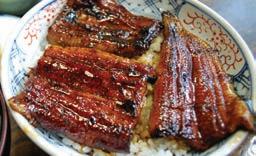
fish dishes in Japan and other Asian countries.
easily digestible form and directly absorbable. Although many Japanese eel larvae survive on this diet and even grow to sexual maturity, the dietary and nutrient requirements of eels remain an urgent research topic. Mortality in the larval phase is very high and numerous animals show more or less severe deformities that can clearly be attributed to nutritional deficiencies. The researchers suspect that the quantity and type of important micronutrients such as ascorbic acid, alpha-tocopherol, arachidonic acid and other fatty acids present in the feed do not correspond to the actual needs of the primarily carnivorous eels.
These gaps in our knowledge must be closed in order to develop costeffective production of healthy glass eels with high survival rates. A shift from stocking with wild eels to farmed glass eels would give a strong impetus to the development of sustainable eel aquaculture. While progress with Japanese eels is encouraging and very promising, we are still a long way from full life-cycle aquaculture technologies for all eel species, including the European varieties. Given the long development period of Anguilla anguilla leptocephali, it is doubtful whether this production can be economically viable.
However, successful attempts have been made in Europe to artificially reproduce and rear the European eel for years. For this purpose, white eels are caught during migration to the spawning grounds and subjected to hormonal stimulation (females typically with carp or salmon pituitary glands, and males with hCG) to induce maturation and facilitate stripping. The hatched larvae usually reach the end of their lifespan after about 20 days. As almost everywhere, researchers in Europe are struggling with poor egg quality, relatively low fertilisation rates, high egg mortality and low hatching rates. However, the biggest problem is finding the right food for the larvae. So far, it has not been possible to get the larvae to feed. In Germany, for example, experiments were conducted with ‘marine snow’, a type of marine detritus, and gelatinous microplankton, but without achieving the expected breakthrough. It was considered a success that the eel larvae showed some interest in this food. However, no food particles were found in their intestines.
Recognised species of the genus Anguilla
The genus Anguilla currently includes 18 species of eels worldwide, which are recognized by taxonomists as relatively secure. According to recent research, all these eel species are believed to be descended from a common ancestor.
Common nameScientific nameDescription of species, year
European eel Anguilla anguilla Linnaeus, 1758
Short-finned eel Anguilla australis Richardson, 1841
Indian mottled eel Anguilla bengalensis Gray, 1831
Indonesian shortfin eel Anguilla bicolor McClelland, 1844
Borneo eel Anguilla borneensis Popta, 1924
Celebes longfin eel Anguilla celebesensis Kaup, 1856
New Zealand longfin eel Anguilla dieffenbachii Gray, 1842
Highlands longfinned eel Anguilla interioris Whitley, 1938
Japanese eel Anguilla japonica Temminck & Schlegel, 1847
Philippine mottled eel Anguilla luzonensis Watanabe, Ayoama & Tsukamoto 2009
Indonesian longfinned eel Anguilla malgumora Kaup, 1856
Giant mottled eel Anguilla marmorata Quoy & Gaimard, 1824
Polynesian longfinned eel Anguilla megastoma Kaup, 1856
African longfin eel
Anguilla mossambica Peters, 1852
Mottled eel Anguilla nebulosa McClelland, 1844
Pacific shortfinned eel Anguilla obscura Günther, 1872
Speckled longfin eel Anguilla reinhardtii Steindachner, 1867
American eel Anguilla rostrata Le Sueur, 1821
The theory of a common origin of the genus Anguilla is supported by studies on the possibility of interbreeding between different eel species. The close relationship and phylogenetic proximity of the species is evidenced, for example, by the successful mating of a female A. australis with a male A. dieffenbachii and a female A. japonica with a male A. anguilla. Such hybridisations are technically very complex, as under natural conditions the species reach the stage of mature spawning eel at different times of the year.
Nevertheless, research efforts to tackle these problems continue worldwide. At the end of 2024, the JAPFA Group from Singapore reported a breakthrough in the production of the tropical eel Anguilla bicolor, a species that is considered a substitute for Anguilla japonica in Asian countries. Both are quite similar in taste and texture. The press release states that after several
years of work to protect the eel population, the researchers have taken the first step towards propagating this tropical eel species in aquaculture. Using advanced techniques and rearing methods, 70,000 larvae were hatched and kept alive for 11 days. It may still be a long way to a major breakthrough, but the eel researchers have certainly shown persistence. Manfred Klinkhardt
VeriFish is developing an effective sustainability indicator framework for consumer information
Sustainability of global food systems is a growing concern, particularly in sectors reliant on natural resources such as fisheries and some aquaculture. VeriFish aims to create a structured and verifiable indicator framework to provide clarity on different aspects of seafood production and consumption (e.g., biodiversity, climate, nutrition) and offer an approach for communicating these to citizens.
The VeriFish indicator framework seeks to provide clarity on different aspects of interest (e.g., climate, nutrition) to communicate sustainability to citizens. Directed by existing international sustainability frameworks and aligning with Food and Agriculture Organization (FAO), International Council for the Exploration of the Sea (ICES), and Scientific, Technical and Economic Committee for Fisheries (STECF) guidelines123, VeriFish is selecting indicators that are measurable, reliable, and actionable, based on scientific data and industry good practices. Each pillar— capture fisheries, aquaculture, and nutrition—has presented unique challenges and required distinct but interconnected approaches to define sustainability.
Fisheries have a crucial role in global food security and in many countries’ economies, yet sustainability is challenged by overfishing, habitat destruction, and now climate change. Pressure on fish stocks has intensified globally due to unsustainable harvesting
practices in some regions, and illegal, unreported, and unregulated (IUU) fishing remains a significant concern, undermining conservation and threatening livelihoods. Many regions have implemented regulatory frameworks (including spatial and temporal restrictions, input and output controls, and technical limitations) to manage fish populations, but enforcement remains difficult. Achieving truly sustainable fisheries requires continuous adaptation to changing ecological conditions and collaboration amongst governments, industry representatives, and conservation organisations.
Environmental sustainability in wild-capture fisheries depends on the health of fish stocks, minimisation of environmental impact, and appropriate governance mechanisms. For VeriFish the primary challenge has been to ensure indicators provide realistic and quantifiable measures of long-term viability/sustainability. Biomass at maximum sustainable yield (BMSY) and fishing mortality at maximum sustainable yield (FMSY) were chosen because they are well-established and credible concepts. Also,
alternatives such as species vulnerability to fishing can be used when this information is not available. Selected environmental indicators evaluate impacts of fishing activities, including habitat degradation, bycatch rates, and carbon emissions. Some techniques, such as bottom trawling, significantly disrupt marine habitats, whilst others have smaller ecological footprints. To reflect these differences, seabed impact was included as a measure of how gear types interact with marine environments.
Similarly, bycatch rates and endangered, threatened, and protected species interactions were selected to quantify unintended ecological consequences. Fuel use per kilogram of landed seafood was chosen because fleets vary in energy consumption, but reducing carbon emissions is essential for sustainability. Finally, governance indicators were incorporated to assess the effectiveness of management policies. Given the prevalence of IUU fishing, the VeriFish framework includes indicators that track compliance with quota systems, marine protected area regulations, and digital
1 FAO and WHO. 2020. Code of Practice for Fish and Fishery Products. Rome. https://doi.org.10.4060/cb0658en
2 https://www.ices.dk/advice/Pages/technical_guidelines.aspx
monitoring mechanisms. Appreciating the role of independent certification schemes, indicators that aligned with good practices were prioritised. Ultimately, indicators for capture fisheries were chosen because they were quantifiable, applicable across different regions, and adaptable to evolving environmental and regulatory conditions.
Aquaculture growth presents both opportunities and challenges. It can reduce pressure on wild fish populations and provide a more sustainable source of seafood, but sustainability depends on production methods and management strategies. Poorly managed aquaculture operations lead to environmental degradation, including waste discharge, habitat destruction, spread of diseases, and increased antimicrobial resistance. Innovative solutions, such as integrated multi-trophic aquaculture and partial/closedloop recirculating systems, are promising alternatives to mitigate these challenges, as are insect meal and algae-based feeds.
3 Scientific, Technical and Economic Committee for Fisheries (STECF) – Criteria and indicators to incorporate sustainability aspects for seafood products in the marketing standards under the Common Market Organisation (STECF-20-05), Gascuel, D. and Druon, J. editor(s), EUR 28359 EN, Publications Office of the European Union, Luxembourg, 2021, ISBN 978-92-76-36158-9, doi:10.2760/211065, JRC124927.























































Authority (EFSA). Sodium content was included because of its link with increased risk of hypertension. Ultimately, selection of nutrition and health indicators reflects dietary significance, public health objectives, and feasibility to measure, ensuring that seafood remains positioned as a sustainable and high-quality nutrient—not just protein—source.
The selection of aquaculture indicators required an approach that could cope with diverse production systems. Feed efficiency emerged because reliance on fishmeal and fish oil derived from wild stocks directly affects sustainability. The fish-in to fish-out ratio quantifies how much wild fish is required to produce one kilogram of farmed seafood, and this indicator was prioritised because a lower ratio signifies reduced pressure on marine food webs. Additionally, the VeriFish framework incorporates metrics assessing use of alternative protein sources as well as water consumption and waste management. Nitrogen and phosphorus emissions were selected because nutrient runoff can lead to eutrophication and damage surrounding ecosystems, and plastic waste circularity measures how effectively farms manage and recycle materials, such as nets and packaging. Operations located in sensitive environments (e.g., wetlands, lagoons) pose greater ecological risks and indicators for habitat impact assessing this were identified as important.
Likewise, disease outbreaks can spill over into wild ecosystems, making disease management and antimicrobial use essential indicators for VeriFish. Animal welfare is reflected in the selection of survival
rate as a proxy for overall management alongside stocking density and stunning practices. These indicators echo those developed by STECF and align with emerging EU animal welfare policies and international aquaculture certification schemes such as the Aquaculture Stewardship Council (ASC). By focusing on feed sustainability, resource efficiency, biosecurity, and waste management, VeriFish has tried to ensure that indicators provide a rigorous yet adaptable framework for assessing aquaculture sustainability.
High-quality protein, essential fatty acids, and micronutrients such as vitamin D, iodine, and selenium make seafood invaluable components of a healthy diet. Understanding the nutrient composition of different species allows individuals to make more informed choices and guides public health policies. By considering the balance between nutritional benefits and environmental impact, the VeriFish framework seeks to ensure consumers receive accurate information about options available to them.
Nutrition and health clearly extend beyond nutritional content to issues such as contamination,
allergenicity, and specific dietary needs in vulnerable populations but these are food safety issues and outside the remit of VeriFish. Instead, the framework incorporates protein content per 100 g “as consumed” because seafood is a high-quality protein source containing all essential amino acids. Essential fatty acids (e.g., eicosapentaenoic and docosahexaenoic acids) were included as indicators not just because of proven health benefits, but also because seafood is the primary human dietary source of these compounds. Micronutrient density was a key consideration and iodine, selenium, and vitamin D were incorporated as key indicators given their role in thyroid function, bone health, and proper functioning of the immune system. These indicators also align with dietary reference intakes established by World Health Organization (WHO), FAO, and the European Food Safety
Effective communication using the VeriFish framework will rely on a diverse range of credible, transparent, and applicable data sources. Where possible, publicly available and internationally recognised datasets have been prioritised to facilitate consistency, comparability, and usability. For capture fisheries, key data sources include ICES, FAO, and the Global Record of Stocks and Fisheries, which provide stock assessment data, fishing mortality rates, and species-specific ecological information. In aquaculture, sustainability indicators are informed by the FAO Global Aquaculture Production database, ASC, and GlobalG.A.P certification reports, ensuring alignment with evolving regulatory and industry best practices. Nutritional data, meanwhile, are primarily drawn from national and regional food composition databases (EuroFIR, AISBL, and

FAO) as well as EFSA and WHO/ FAO guidelines. In areas where reliable public data are limited, the framework will incorporate socalled Tier 2 data, requiring input directly from seafood producers and value chain actors. These industry-provided datasets enable granular assessments of sustainability practices at the production level but necessitate careful validation to maintain data integrity.
Ensuring high-quality, reliable, and verifiable data is fundamental to the credibility not only of the VeriFish framework but also the communications it will underpin. Use of validated methodologies, standardised and ideally harmonised datasets will help mitigate inconsistency, bias, and
incomplete reporting. However, challenges remain in certain areas, particularly where data availability varies by region, production system, and/or species. In fisheries, stock assessment data can be incomplete or outdated, necessitating cross-validation with multiple sources to ensure accuracy. Similarly, in aquaculture, feed conversion ratios, antibiotic usage, and waste management practices depend on industry-reported data, which require independent verification through audits, certification schemes, and compliance checks.
The VeriFish framework emphasises FAIR data principles4 to ensure transparency and usability. In cases where data gaps exist, VeriFish will recommend these
are filled or verified proxy indicators and modelling approaches adopted, ensuring that sustainability assessments remain robust and relevant over time.
Achieving a truly sustainable seafood industry requires continued investment in research, technology, and public engagement. Policymakers, businesses, and consumers all have a role in ensuring the long-term health of marine resources and, by fostering global responsibility and transparency, transition to sustainable food systems can be realised, securing both marine ecosystems and livelihoods for the future.
Siân Astley, Secretary General, EuroFIR AISBL, sa@eurofir.org
4 Wilkinson, M., Dumontier, M., Aalbersberg, I. et al. The FAIR Guiding Principles for scientific data management and stewardship. Sci Data 3, 160018 (2016). https://doi.org/10.1038/sdata.2016.18

SEPTEMBER 22-25

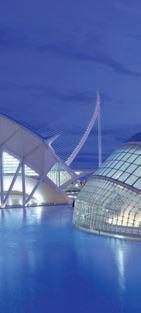


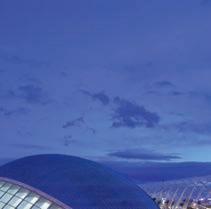

Coordinated by Trust-IT Services, the VeriFish consortium comprises eight European partners from eight countries, bringing complementary skills and expertise from COMMpla (Trust-IT affiliated entity), FORTH, NOFIMA, Eurofish, EuroFIR, Premotec, and Clupea consultancy. The project runs from May 2024 until April 2026 and is funded by the European Union under grant agreement no.: 101156426
Website: http://verifish.info/ Social media: https://x.com/ Verfish_project, https://www. linkedin.com/company/ verifishproject
Further reading https://zenodo. org/records/14384281










The fishery for deep-water red shrimps is of great commercial significance for Mazara del Vallo on Sicily, where many deepsea trawlers targeting these crustaceans are based. The resource is overfished, however, and measures introduced to protect these valuable shrimps have had repercussions on the fleet.
Founded in 1961, Federpesca represents Italian shipowners and companies operating vessels over 12 LFT that fish beyond 12 nautical miles. With more than 1,600 enterprises and 7,000 associated members spread across 40 branch offices, the organisation provides practical support to its members in legal, technical, economic, and regulatory matters. In a recent interview, Francesca Biondo, the director of Federpesca, explains how the deep-water red shrimp fishing fleet in Mazara del Vallo has changed over time and outlined the challenges the industry now faces.
The history of the Mazara del Vallo fleet provides a clear example of how traditional practices have evolved in response to technological and regulatory changes. Fishing in this area dates to the Phoenician era, when small wooden sailing boats were the norm. Today, the vessels are made of iron and steel and are usually 30 m in length. They are equipped with onboard freezing systems and storage holds, allowing them to remain at sea for extended periods—up to 30 or 45 days. This capacity for longer trips has enabled the fleet to operate throughout the Mediterranean, shifting its focus from the capture
of fresh fish to the exploitation of crustaceans, which are frozen on board immediately after being caught.
At its peak, the Mazara fleet numbered around 400 vessels, making it the largest deep-water red shrimp fleet in Italy. However, over recent decades the number of vessels has declined sharply to just over 80. The reduction has been driven primarily by economic pressures, with high fuel costs representing one of the most significant challenges. Operating expenses, which account for roughly onefifth of total costs, have also risen considerably. In addition, European regulations have further constrained the industry by introducing stricter quotas and limiting fishing opportunities. These factors have combined to reduce the income and operational capacity of fishers, who have had to adjust their practices and, in some cases, reduce the number of active vessels.
The primary fishing grounds for the Mazara fleet are located in the Sicilian Channel and the Central Mediterranean, specifically
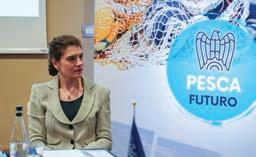
competition.
within FAO zone 37.2.2. A smaller number of vessels operate near Greece and south of Sardinia. These areas are characterised by muddy sea beds that are favourable for both the giant red shrimp and the blue and red shrimp.
In 2022, the General Fisheries Commission for the Mediterranean introduced multiannual management plans for shrimp fisheries in the Strait of Sicily, the Ionian Sea, and the Levant Sea. These plans, which include measures designed to achieve maximum sustainable yield by 2030, protect nursery and spawning grounds, eliminate discards, and prevent increases in fishing capacity, have had a significant impact on the industry. While the environmental objectives of the plans are necessary, the
new measures have resulted in reduced fishing opportunities and lower yields for Italian fishers, says Ms Biondo. Stricter quotas and changes in fishing practices have forced many operators to adjust their strategies, including reducing the number of vessels in use or modifying their fishing gear to comply with the new regulations. The impact on income and capacity has been considerable, and Ms Biondo stresses that the measures must be applied uniformly across all Mediterranean countries to prevent unfair competition.
Protect the fisher as well as the fish
Federpesca’s role in this regulatory environment is multifaceted.

The organisation not only explains to its members the necessity of these management plans but also participates in consultations with the bodies responsible for drafting them. Federpesca is active in discussions with EU institutions, the GFCM, and ICCAT, offering feedback based on the practical experiences of Italian fishers. Its involvement in meetings, such as those held by the MEDAC, is intended to ensure that the policies under discussion consider the realities faced by the fishing community. Federpesca supports the objectives of the management plans—provided they are implemented in a way that protects both the marine environment and the economic viability of the industry. The organisation maintains that the sustainability goals of achieving maximum sustainable yield and protecting critical habitats should not come at the expense of the livelihoods of fishers.
Looking ahead, new regulations set to take effect in 2026 require the adoption of minimum conservation reference sizes to protect juvenile shrimp. Federpesca anticipates that these measures will place an additional economic burden on Italian fishers, who may be forced to adopt more selective fishing gear or relocate to different fishing grounds. The potential changes in fishing practices represent another challenge in an industry already under pressure from high operating costs and stringent regulations. Federpesca has consistently emphasised the need for these measures to be applied uniformly across Mediterranean nations to avoid competitive imbalances. Without a coordinated approach, Italian fishers may be further disadvantaged in comparison to their counterparts in other countries.
Competition from non-EU fleets adds another layer of complexity to the Mediterranean shrimp fishery. The Italian industrial fishing fleet, which largely operates in international waters, faces stiff competition from both EU and non-EU operators. Federpesca has pointed out that Italy’s unilateral regulatory efforts, while well-intentioned, have not been matched by similar measures in other Mediterranean countries. This discrepancy has resulted in unfair competition, with non-EU fleets often operating under less restrictive conditions. The outcome has been a reduction in the number of fishing units, job losses, and an overall decline in production within the Italian industry. Federpesca advocates for stronger controls on non-EU products and supports the idea of a national campaign to promote Italian seafood, measures that it believes would help level the playing field. The organisation argues that shared management measures across all countries operating in the Mediterranean are necessary to ensure a sustainable and equitable fishery.
In recent years, the transition to electronic logbooks has modernised the way catches are recorded. Fishing vessels have been using electronic logbooks for several years, and most fishers have adapted to the change. These digital systems offer more accurate and efficient reporting compared to the old paper-based methods. However, Federpesca notes that further training may be required to ensure that all crew members are proficient with the new technology. The improved record-keeping provided by electronic logbooks facilitates better compliance with regulatory requirements and
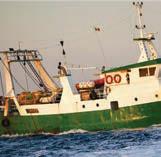


Deep-water shrimp trawlers today can sail for a month at a time and are equipped to freeze the catch on board.
helps authorities monitor fishing activities more effectively.
Climate change has also had a noticeable impact on the Mediterranean shrimp fishery. Changes in the marine ecosystem have led to shifts in shrimp populations, migration patterns, and overall catch volumes. The number of days available for fishing has dropped significantly, from 365 days in the past to approximately 150 days per year today. This reduction in available fishing time has forced fishers to focus their efforts on species that can still provide a reliable yield under the new environmental conditions, with crustaceans increasingly becoming the target over other types of fish. Although the industry continues to adapt to these changes, Federpesca insists that a common fisheries policy for the Mediterranean is needed to ensure that all countries adhere to the same sustainable practices.
The giant red shrimp and the blue and red shrimp fisheries are thus
facing a host of challenges that stem from both economic and environmental pressures. High fuel costs, elevated operating expenses, and stringent regulations have significantly reduced the size and capacity of the fleet. Meanwhile, the need for sustainability has led to the implementation of management plans that, while environmentally beneficial, have constrained fishing opportunities and reduced income for many operators. Federpesca has worked to ensure that the concerns of Italian fishers are communicated clearly to policymakers and that the measures being adopted do not undermine the economic viability of the industry.
The current state of the giant red shrimp and the blue and red shrimp fishery in the Mediterranean reflects decades of change in technology, regulation, and market conditions. The future of the shrimp fishery depends on the ability of all stakeholders to work together to address environmental challenges, modernise operational practices, and create a level playing field in an increasingly competitive global market.

Rosso di Mazara: A tradition of excellence in Mediterranean seafood
A company in Mazara del Vallo on Sicily fishes for deepwater red shrimps, a very high value item. Parts of the shrimp that would normally be discarded, such as the heads and the shells, are used to create new products and at the same time reduce the waste.
The Mediterranean Sea is home to a wide variety of fish species many of which are of commercial importance. However, it is also subject to several stressors including pollution, climate change impacts, overfishing, invasive species, and an increasing number of spacedemanding human activities, such as transport, oil and gas, renewable energy, and aquaculture among others.
More than 20 countries border the Mediterranean Sea including eight EU Member States and some 150 million people live along the coasts, a number that doubles in the tourist season. The EU fishing fleet in the Mediterranean amounts to over 30,000 vessels, one-fifth of which are large-scale. These big vessels are responsible for 85 of the volume of landings and 74 of the value, according to a report from the European parliament. Sardines and anchovies are the top species in terms of landed weight while bluefin tuna, anchovy, hake, and deepwater rose shrimp (Parapenaeus
longirostris) represent the highest landed values. The latter is trawled at depths of 200-500 m, but further down the water column at depths of 400-800 m two other shrimp species are targeted. These are the giant red shrimp, Aristaeomorpha foliacea, and the blue and red shrimp, Aristeus antennatus, both highly prized by deep-sea trawl fishers. These two species comprise the deep-water red shrimps. In the EU Italy is the biggest producer of these shrimps accounting for three-fourths of the total European volume and Mazara del Vallo hosts the biggest fleet of bottom trawlers specialised in catching these crustaceans, states a paper1 by Monica Gambino and colleagues.
The fishery for these species by trawlers from Mazara del Vallo on Sicily has a long history. According to Fabio Fiorentino and his coauthors in an article2, the fishery for A. foliacea began in the 70s in the Strait of Sicily between Sicily and Tunisia. Until the mid-1980s catches were estimated to be sustainable, but then productivity began to decline. According to the CNR IRBIM database catch rates in this area fell from 8 kg/h in the mid-70s to 3 kg/h in the mid-90s
1 Shared fish stocks in the Mediterranean: Management of the giant red shrimp fishery in the Strait of Sicily, 2024, Mediterranean Economies 2024
2 Learning from the history of red shrimp fisheries in the Mediterranean to improve sustainability of deep-water bottom trawling, 2024, ICES Journal of Marine Science, 2024, Vol. 0, Issue 0, 1–13






















































General Fisheries Commission for the Mediterranean (GFCM) geographical subareas
and slumped to 0.3-0.5 kg/h at the beginning of the 2020s. Researchers too sounded the alarm in the 2000s and 2010s recommending a reduction in fishing pressure and the use of more selective fishing gear. In search of better yields



vessels progressively extended their operations southeast reaching the area off the Libyan coast in the late 1980s-early 1990s. When Libya in 2005 extended its national fisheries protection zone effectively disbarring the Italian

The shrimps are frozen and packaged on board so they are ready to be shipped to buyers as soon as the vessel returns to port.

































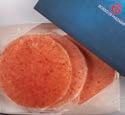
vessels, they moved further eastwards. From the mid-2000s to the present day the vessels have been fishing in waters off Crete, Egypt, Libya, Rhodes, Cyprus, and Türkiye. Catches were frozen on board and landed at ports in Greece or Cyprus and trucked back to Mazara del Vallo for distribution throughout Italy.
However, stocks of deep-water red shrimps were not being fished sustainably and in 2022 the GFCM adopted three multiannual management plans for the deep-water red shrimp fishery covering the Strait of Sicily, the Ionian Sea, and the Levant Sea. In 2023, 24, and 25 the plans foresee a transitional
fishing regime during which scientists gather information about the stocks that will shape management measures for the long-term management plan established for the years 2026-2030. The plans seek to bring exploitation to MSY levels at least by the end of 2030. Among the measures to achieve this is one limiting capacity of the fleet fishing deep-water red shrimps to the level of 2019. Another stipulates that the catch quota shall be reduced by 3 each year from 2023 to 2025. Moreover, the transitional phase of the plans (2023 to 2025) stipulates a 30-consecutive-day fishing closure between March and September. In 2025, the Italian quota of giant red shrimp in the Strait of Sicily, the Ionian Sea, and the Levant Sea is 818, 294, and 45 tonnes respectively, while for blue and red shrimp it is 95, 236, and 9 tonnes.
Some fishers targeting these species are vertically integrating to derive the maximum value from the catch. These efforts include branding, creating highly valueadded products, and developing markets around the world. A good example is Rosso di Mazara, a family-owned Mazara del Vallo fishing company that dates to the early 20th century. Today it is run by the brothers Nicola and Paolo Giacalone who have taken
over from their father. Fishing for deep-water red shrimps started in the mid-80s and today the fleet comprises six vessels that target these species in the Strait of Sicily and in the waters off Malta. These are frozen, packaged and distributed under the brand name Rosso di Mazara. Over the years the company has adopted new practices to adapt to the times and to the demands of its markets. For example, the products are certified to the Friend of the Sea standard. Among the measures it takes to qualify for this certification is to install cameras on the nets to monitor whether they touch the seabed. Another initiative is to use turtle excluding devices to prevent the accidental bycatch of turtles. We also supported the TartaLife project, says Nicola Giacalone, which was dedicated to reducing turtle mortality by commercial fishing.
We must innovate if we want to thrive in this business, he states, even though fishing is generally a very conservative profession. The company has therefore developed and launched new products based on the shrimp it catches in collaboration with the Department of Biological, Chemical and Pharmaceutical Sciences and Technologies at the University of Palermo. The project, Innovittica, sought to add value to fish waste by extracting ingredients that could be used in the pharmaceutical, nutraceutical, and cosmetic industries. For Rosso di Mazara the objective was to add value to the waste from the shrimp processing, in effect using all the parts of the shrimp and discarding little or nothing. This has resulted, among other products, in a shrimp essence made from the heads. These are super-frozen at minus 50 degrees
when the shrimps are caught to lock in the freshness and trap all the nutrients. The heads are then processed to create the essence, which is elegantly packaged and marketed. The essence is highly versatile and can be used in combination with risotto, pasta, or even pizza, among other dishes. Another product is a bisque, a kind of soup, that is also made from the heads of the prawns. Here too the company packages, brands, and markets the product as a gourmet item (a 100 ml jar costs EUR40 in their online shop). While the traditional shrimp product is whole-frozen there is also a peeled-and-frozen product as well as a powder made from freezedried shrimp that is blended with herbs, and a carpaccio made from a blend of two kinds of shrimp, the giant red shrimp and the soldier striped shrimp (Plesionika edwardsii). Moreover, the company has developed, in collaboration with a German firm, ways to use the pigment astaxanthin, a powerful antioxidant, which is present in the shell of the shrimp. In keeping with its environmental awareness, the company eschews plastic packaging for its products using only paper and cardboard from renewable sources. Nothing is thrown into the sea, says Mr Giacalone, and we try and keep our operations as sustainable as possible. This effort includes having the shrimp DNA-certified by an independent auditor to confirm the biological and geographical origin.
The company’s catches have hovered around 100 tonnes a year for the past few years. Since 2023 they have depended on the quota allocated to the relevant geographical subarea by the GFCM

multiannual management plan for that subarea. The shrimps are typically harvested at depths of between 400 and 800 m. When they arrive on board, the shrimp are sorted into categories and are then frozen and packaged so that they are ready to be shipped to their destination as soon as the vessel lands. Any damaged animals or broken heads or legs are also frozen for further processing on land. The shrimps are distributed across Europe as well as Asia, and the United States and the company has been a prolific user of social media to promote and sell the product.
Mr Giacalone also sells on the Italian market but would rather export as the prices are better and do not fluctuate as much. Overseas customers appreciate the quality and the value-addition we provide and are willing to pay for it, he says. The company will shortly open an office in Libya and move some of its vessels there to exploit the availability of shrimp in Libyan waters. Sales and marketing of the production are likely to remain in Italy, however. The move will be another step in Rosso di Mazara’s evolution since it was founded over a century ago.
Via Mario Fani N. 35 Mazara del Vallo Italy
Tel.: +39 347 374 2032 info@rossodimazara.eu https://www.rossodimazara.com
Founder: Nicola Giacalone
Fleet captain: Paolo Giacalone
Activity: Fishing for deep-water red shrimps (giant red shrimp, Aristaeomorpha foliacea;
blue and red shrimp, Aristeus antennatus)
Fishing grounds: Strait of Sicily; waters off Malta
Volume: 100 tonnes/year
Vessels: 6
Processing: On-board freezing
Products: Whole frozen shrimp; peeled shrimp; shrimp carpaccio; shrimp powder; shrimp bisque; shrimp bouillon
GNC Bluray offers LED lighting solutions for aquaculture and other applications
Light can have positive effects on fish and other living creatures grown in captivity. Researchers are studying how light works in this context with a view to optimising the growth of corals, plants and fish.
Founded in 2009 by Mario Giulietti, GNC Bluray has established itself as a leader in LED lighting solutions for aquariums and scientific applications. With expertise in electronics, mechanics, and LED technology, Mr Giulietti’s vision was to apply advanced lighting techniques to enhance aquatic ecosystems. Over the years, GNC has collaborated with research institutions such as the University of Perugia, refining its lighting technology to better replicate natural ecosystems in marine and freshwater environments.
GNC operates through two primary branches: GNC SRL in Italy, which handles production and research and development, and a sister company in Florida, USA, responsible for sales and distribution across North America. While all design and manufacturing occur in Italy, the Florida office facilitates businessto-business (B2B) and businessto-consumer (B2C) transactions, focusing on market expansion in the United States, Canada, and Mexico. We are also considering establishing a manufacturing unit there in the future, says Andrea Bettini, the company CEO, which would be in addition to our existing facility in Italy.
GNC specialises in developing high-quality LED lighting solutions tailored to various applications, from ornamental aquariums to scientific research and aquaculture. The core principle behind GNC’s lighting systems is the careful modulation of LED wavelengths to support biological growth processes. The company uses its LED systems to recreate the natural light that animals and plants need to thrive. Light is crucial for all phases of the lifecycle. When referring to fish, this means the larval, growth, and adult stages. As light influences growth and—among other effects—the production of vitamin D, which reduces the risk of skeletal deformities, the ‘right light’ is important. Moreover, the photoperiod and the intensity of the LEDs can be adjusted to the species being cultivated. What our systems do, Mr Bettini explains, is to mimic natural light conditions. This means not just recreating sunlight but also taking into account other factors that influence light conditions such as


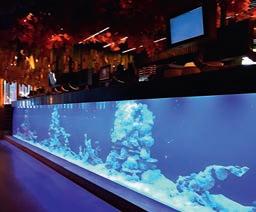
air humidity, gases in the atmosphere, cloud coverage, the season, and the latitude and longitude. Finally, the lights have to be used for organisms growing underwater, perhaps at different depths, which adds further levels of complexity to the system. The water may contain dissolved materials or phytoplankton or zooplankton that affects how the light shines on the organisms being cultivated.
A GNC lamp comprises an array of LEDs that emit light of different wavelengths. For example, one of the lamps, the Blu-ray X has 536 LEDs on board, of which 308 are blue, 168 are white, 12 are red, etc. Another product, the Silver Moon Marine series, is a bar, the shortest version of which incorporates 21 white and 21 blue LEDs. The longest bar in the series has 100 white and 75 blue LEDs on board. The more sophisticated (and expensive) lamps can thus replicate the full spectrum of wavelengths found in sunlight. A user can tailor the different parameters, such as light intensity and photoperiod of each colour, and even vary cloud cover using an app, the GNC Neeos, that is made
for both iOS and Android, if they so desire. The app also has several preprogrammed settings for certain scenarios (currently only for coral growing), which some users may prefer to setting each parameter manually. We are working on a more sophisticated version of the app, says Mr Bettini, to be used by research institutes, where the scientist can recreate the light conditions of a specific latitude and longitude for each day in the year if they need to.
For its lamps GNC uses a unique combination of LED wavelengths focusing on light spectrum optimisation to enhance physiological and chemical processes in marine and freshwater environments. The company collaborates directly with LED manufacturers to customise the LEDs and ensure reliable, long-lasting performance. The components, LEDs, power supply, cooling units, lamp housing, diffusers etc., come from different suppliers and are assembled into a lamp at GNC’s own manufacturing facility in Perugia. While
many of the products are used to breed corals, GNC is also eyeing the aquaculture market with interest after visiting a big aquaculture event AQUA 2024 that was held in Copenhagen last year. Mr Bettini sees the potential of using lamps to attain optimal growth rates and feed conversion ratios among farmed fish. GNC is already providing lamps for the cultivation of microalgae in bioreactors, and the company works closely with farmers who grow plants in water—and outside—if the scale of production is large enough. Scale is important in this market because it allows the company to compete with cheaper manufacturers. Another area in which the company is active is the pharmaceutical plants industry, but the main area of activity is the production of lamps for different aquatic-based needs.
We have a different philosophy than many of our competitors in the business, Mr Bettini says. They work with large, powerful LEDs and use active cooling systems to dissipate the heat generated. We find that the environment in which we operate is highly stressful for electronics due to the presence of water, dust, and salt, and this exacts a cost on active cooling systems, making them prone to breakdowns and shortening their lifespan. Therefore, all the GNC




lamps are passively cooled with specially designed cooling ribs. Another factor is that GNC lamps reproduce sunlight which is a diffuse light. Mr Bettini explains that the best way to do this is by using many small LEDs close to each other. In this configuration they do not create shadow areas. Heat is dissipated passively with the help of cooling ribs mounted on the lamp, and the operational temperature lies between 40 and 48 degrees, in contrast to the 50 to 55 degrees of larger, more powerful lamps. The lower temperature range contributes to the durability of the lamps. The company optimises the cooling ribs by playing with the design and testing different shapes and lengths to see which is the most effective at dissipating heat. LED technology is in a state of rapid developments, but GNC ensures the LEDs in its lamps are always the latest generation as the manufacturer upgrades every six months or so. Newer LEDs may consume less power, for example, or offer other features such as improved durability. The lamps that GNC produces today use e.g. 170 watts, where before it was 400 to 500 watts, with the same light output. Customer feedback is an important source of information about how the lamps should be further developed. Since many of the customers are universities





and other professionals, GNC gets feedback that is particularly valuable for the evolution of their lamps.
One of GNC’s most ambitious projects is a partnership with KAUST, the King Abdullah University of Science and Technology, in Saudi Arabia. A project that will develop the world’s largest coral nursery (it will correspond to five football pitches). The $140 million initiative aims
to produce and transplant up to 400,000 corals annually, playing a significant role in marine conservation. With its role in the KAUST project, GNC Bluray has also positioned itself as a pioneer in the LED lighting industry, balancing innovation with environmental responsibility. With its cutting-edge technology, strategic collaborations, and commitment to excellence, the company is set to expand its influence across both commercial and scientific domains, further solidifying its status as a global leader in specialised LED solutions.
Via dei Salici 17/19
06083 Bastia Umbra (PG) Italy
Tel.: +39 328 752 9866 store@gncitalia.it www.gncleditalia.com
Founder: Mario Giulietti CEO: Andrea Bettini
Activity: Production of LED lamps for aquariums, aquaculture
systems, plant farming indoors, corals, bioreactors for microalgae
Products: Lamps of different shapes, sizes, powers, and numbers of LEDs
Italy office: Design, production, sales and marketing
USA office: Sales and marketing B2B and B2C in North America
AquaFarm has established itself as an event for the international fish and shellfish farming sector to promote products and services, gather and disseminate information, and to network.
AquaFarm 2025 brought together companies from across Europe involved in fish and shellfish farming. Spanning 7,000 square meters and hosting over 100 exhibitors, the event featured a strong Italian presence, with participants from all segments of the industry, including producers, technology manufacturers, feed suppliers, service providers, NGOs, government bodies, and associations. Over the past eight years, AquaFarm has evolved into a major reference point for the industry, providing up-to-date information, facilitating collaboration among exhibitors, experts, and academics, and featuring international speakers.
Since its first edition in 2017, AquaFarm has undergone a significant


evolution. Initially focused on providing an overview of Italy’s aquaculture industry, the event has expanded its scope to address broader themes such as distribution, consumption trends, and sustainability. This growth highlights the commitment of aquaculture entrepreneurs to enhance production through sustainability, quality, and innovation. The 2025 edition emphasised the industry’s dedication to balancing growth with environmental responsibility and provided a platform for industry professionals, researchers, and policymakers to engage in several discussions.
Aquafarm 2025 opens with a focus on energy transition, innovation and tradition
The fair opened with the official inauguration by authorities, coinciding with the launch of the conference program, which kicked off with a session on a key industry challenge. Titled “Decarbonisation and energy self-generation and consumption in aquaculture,” the session tried to explore the state of decarbonisation in the sector with discussions also extending to broader topics, including policy developments, sustainability strategies, cultural heritage, by-product reutilisation, and aquaponics (see following article on p. 34).
Alfonso Macías Dorado from ASENA spoke about balancing aquaculture, environmental sustainability, and local cultural heritage in Andalusia. Mr Dorado introduced a proposal to designate the Bay of Cádiz as a Global Important Agricultural Heritage System (GIAHS) under FAO, recognising its rich history, biodiversity, and traditional aquaculture practices. The initiative, developed through collaboration with government agencies, universities, and research
institutions, aims to showcase the sector’s role in ecosystem preservation and food security. Fabrizio Capoccioni from CREA introduced Integrated Multi-Trophic Aquaculture (IMTA) as a sustainable farming model, showcasing its potential for implementation in Italy through the Blue Boost project. IMTA integrates species from various trophic levels—such as fish, molluscs, and macroalgae— to improve production efficiency, enhance water quality, and diversify farm income. Co-funded by the EU, the project is developing commercial-scale IMTA systems at several Mediterranean sites, including Italy, to evaluate their feasibility, environmental benefits, and economic viability.
Over the course of the two-day event, several sessions focused on various aspects of bivalve cultivation. Eraldo Rambaldi, General Manager of the Italian Mediterranean Aquaculture Association (AMA), along with his colleagues, introduced three key projects that AMA is involved in: Lifemuscles, Marinet, and Biobased. These initiatives share a common goal of promoting sustainable aquaculture, environmental conservation, and innovation in the Adriatic region. Lifemuscles focuses on reducing plastic waste in mussel farming by implementing biodegradable nets, while Marinet develops digital monitoring systems for sea quality and farmed species. Biobased aims to advance integrated multitrophic aquaculture (IMTA) and improve the value of seaweeds and aquaculture by-products through a biorefinery approach, creating high-value compounds and functional feeds for aquaculture.
Another project featured at the Veneto Region pavilion was

Federico Pinza, president of the Mediterranean Aquaculture Association (AMA), a body that represents over three fourths of Italian production of shellfish, discussed the challenges facing his members.
VeNets, an initiative aimed at fostering connections and collaboration among six Venetian producer organisations, with a strong emphasis on bivalve production. These producers have effectively organised and structured themselves to create innovative, valueadded products. VeNets seeks to showcase the producers, their products, and their territories, positioning them at the heart of the seafood supply chain with a unique and recognisable identity that extends beyond the regional level. At the fair, visitors had the chance to sample a variety of local delicacies, including fasolari, mussels, and oysters, all prepared by a local chef. VeNets represents a good example of collaborations within and between POs.
However, often regulatory and structural challenges further complicate the situation, explained
Federico Pinza, president of AMA, to Eurofish in an interview. Many companies in the sector are small, often operating as microenterprises. This fragmentation makes it difficult for all producers to join larger producer organisations, which could offer more support and better bargaining power. Despite recent efforts to encourage organisation among the producers, the scattered nature of these businesses continues to be a significant obstacle. The lengthy and sometimes cumbersome process of obtaining necessary permits also slows progress.
Shellfish farming has a long-standing tradition in Italy but now faces a range of modern challenges. The Italian Mediterranean Aquaculture Association represents over 1,100 companies in this sector, corresponding to more than 75 of the country’s total shellfish production, Mr Pinza, mentioned. The industry has traditionally focused on farming mussels and clams. However, recent environmental

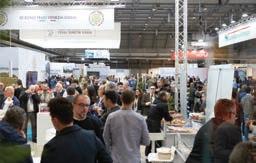
Aquaculture producers, technology manufacturers, feed suppliers, service providers, NGOs, government bodies, and associations were all present at the event, conveying an idea of the depth of the sector.
changes have forced many farmers to rethink their methods. Rising sea temperatures have put mussel farms under significant stress leading to losses that have made diversification a necessity. The only way to prevent mortalities at sea is to sell the product before the onset of the critical period, when temperatures rise. Reducing the density of mussel breeding, changing the depth at which the bivalves are grown, reducing stress by limiting or eliminating reintroduction phases, and oxygenating the water, as is done on intensive fish farms, are measures that could mitigate the problem of rising temperatures. Many farmers are now turning to oyster farming, a practice that has grown rapidly in the past year. There is also a growing interest in cultivating algae as an additional source of income. This shift in focus illustrates a cautious but determined effort to adapt to changing conditions. Other species more resistant to higher temperatures exist, says Mr Pinza, but growing them in the Mediterranean Sea is not practical for environmental and regulatory reasons.
Seed collection is another area where practices vary by species. Mussel spat is still largely collected naturally from the
environment. In contrast, the seed for oysters and clams come almost entirely from hatcheries, both in Europe and from other parts of the world. While this method ensures that there is enough seed to meet demand, it also highlights the challenges of relying on external sources. The industry is also confronting environmental sustainability issues, says Mr Pinza. For example, the nets used in mussel farming are typically made from synthetic materials. These nets are durable, yet they pose long-term environmental risks if not properly managed. Projects supported by national and European initiatives are working on alternatives, such as biodegradable nets and recycling programs for used materials. However, the cost of these new materials and systems remains a barrier for many small producers. By participating in these various projects, AMA is able to learn, test, and promote innovative solutions to support its members’ efforts to tackle these challenges.
The threat from predation is linked to climate change
In a climate change context, innovation is also crucial in the blue
crab emergency, which has had a dramatic impact on clam farms in certain areas, particularly in the Po River Delta. Nearly 500 companies have been forced to close in one severely affected area. Although the government has allocated funds and appointed a special commissioner to address the issue, the crisis underscores the vulnerability of the industry to sudden environmental threats. Some immediate measures, such as fencing off areas to keep out blue crabs and intensifying crab fishing, have been proposed as temporary fixes. Predation by seabream and turtles and understanding how to limit the damage caused by climate change are among the other priorities for Mr Pinza during his term as president. He would also like to see support from EU funds.
On the second day of the fair, Claudio Pedroni, President of Agroittica Toscana and newly elected Executive Vice President of the Associazione Piscicoltori Italiani (API), addressed the growing challenges climate change poses to aquaculture. He emphasised that the industry cannot remain unaffected by global environmental shifts, highlighting concerns such as fish health, the sustainability of marine farming, and the need for preventive strategies to mitigate risks. Ensuring the stability of offshore farming structures and incorporating organic design principles are essential, particularly as large-scale retailers increasingly demand highquality, sustainably produced seafood. The discussion emphasised the need for stricter regulations and improved monitoring systems to support sustainable aquaculture practices. Integrating good farming practices with technological innovations is crucial toovercoming current and future challenges.
Ensuring animal welfare remains a top priority, requiring careful monitoring throughout the production chain. In Italy, efforts are already underway to enhance fish resilience and reduce disease outbreaks. Measures such as early vaccination and micro-encapsulation techniques for fish feed are being explored to improve fish health and overall sustainability. AquaFarm also served as a platform for API to present the Manuale Benessere Specie Ittiche Allevate (Farmed Fish Species Welfare Manual), developed in collaboration with the Istituto Zooprofilattico Sperimentale delle Venezie. The guide provides aquaculture operators with practical tools to assess and maintain fish welfare across various production systems.
Sara Nicolini, a veterinarian from Compassion in World Farming (CIWF), spoke about animal welfare standards in the session “Aquaculture and Fishing Products with Added Value: Balancing Short Supply Chains and Sustainability.” CIWF, an NGO dedicated to improving farm animal welfare and promoting sustainable food production, advocates for higher standards in aquaculture. The organisation focuses on key welfare aspects such as water quality, humane slaughter methods, appropriate stocking densities, and species-specific care, while also raising concerns about the environmental impact of intensive fish farming. Speaking to Eurofish, Ms Nicolini shared the challenges she faces when visiting farms in Italy and engaging with farmers on animal welfare— a relatively new area of focus in the aquaculture industry. The conversation also touched on the
complexities of introducing an additional certification or logo, exploring the perspectives of both farmers and consumers on the feasibility and impact of such a standard.
The session “Youth and aquaculture: Building a sustainable, innovative, and inclusive sector today” explored the challenges of attracting new talent to the industry. After hearing the personal experiences of several young adults working in the sector the discussions centered on the difficulties young entrepreneurs face, as in accessing European Maritime, Fisheries and Aquaculture Fund (EMFAF) support to launch their businesses. Other key concerns included the growing preference for technical careers over direct farm operations. A significant trend observed within the industry is that young professionals with higher education degrees often gravitate toward specialised roles rather than establishing farms. While data at the EU level shows that 34 of those employed in aquaculture are under 39 years old—an age that is gradually increasing—only 7 of them have advanced educational qualifications. This gap in training and education remains a critical issue for the sector’s long-term development. “Youth engagement in aquaculture presents a valuable opportunity for growth, not only in terms of workforce but also in education and professional development,” remarked Prof. Giorgia Gioacchini from the Politecnica delle Marche University. “As an academic, I see pathways that could support young professionals in advancing their knowledge and skills. The key questions are: how many young people are currently


involved in the sector, and how can we enhance their training?”
Young professionals are essential to overcoming the challenges facing the expansion of both marine and continental aquaculture. Strengthening their expertise and fostering a culture of continuous learning will be crucial for driving sustainable growth in the industry across both Italy and the broader European Union.
This concern extends to the bivalve farming sector, where industry is also facing the challenge of attracting new talent, as Mr Piza says. There are few young people entering the field, partly because the industry does not offer many dedicated educational programs. This lack of new talent could hinder the long-term sustainability of the sector. However, there is some hope in the form of value-added processing. Innovations like modified atmosphere packaging and organic certification are helping to extend the shelf life of fresh products and open up new market opportunities, which could, in turn, make
the industry more appealing to a younger generation.
Despite the challenges, there are promising developments that could make the sector more attractive to young professionals. Innovations such as modified atmosphere packaging and organic certification are enhancing the shelf life of fresh products and expanding market opportunities. These advancements not only improve economic prospects but also demonstrate the potential for modernisation and valueadded processing, which could draw more young entrepreneurs into the field.
In addition to attending the conference sessions, visitors could engage with various companies and explore their products. Ocean Twist Biotechnology (formerly known as Ittinsect) has made significant progress in improving the performance of protein ingredients integrated into fish feed,
which is distributed across Europe. At a session on innovative aquaculture practices, the company CEO shared research on the effects of using a hydrolysed black soldier fly (Hermetia illucens) protein concentrate with reduced chitin content on the growth of juvenile Atlantic salmon (Salmo salar). This research describes repurposing agricultural side streams and insect meals as a sustainable protein replacement for traditional fishmeal, thereby reducing human impact on marine ecosystems.
Since its establishment eight years ago, AquaFarm continues to be a key event for the Italian aquaculture sector and beyond. The event continues to serve as an important platform for industry professionals to share the latest developments, address challenges, and explore new collaborations to support the future of the industry. The 9th edition of AquaFarm is scheduled for 18 and 19 February 2026 at Pordenone Fiere.
Francesca
Barazzetta,
Eurofish, francesca@eurofish.dk

shellfishfarming
A session at the AquaFarm conference held recently in Pordenone was dedicated to ways the European aquaculture industry could contribute to the goal of net zero emissions by 2050.
The urgent need to address climate change and environmental degradation led to the development of the European Green Deal, an EU strategy that aims to make the EU carbon neutral by 2050. Achieving this calls for changes across all production sectors—including aquaculture. The European Commission facilitates the adjustments that are called for by coordinating initiatives across EU countries, said Evi Lardi from DG Mare speaking at the session on decarbonisation in the aquaculture sector at AquaFarm in Pordenone. And the commission can help countries identify and execute the reforms needed to achieve the objectives of the Green Deal.
Support from the European Maritime, Fisheries, and Aquaculture Fund as well as from research funds, is available to ease the transition. She highlighted the fact that while aquaculture in other regions of the world is the most rapidly growing food production sector, output in the EU stagnates The aim is to grow the industry in a sustainable manner, she said, that cuts reliance on fossil fuels which, apart from other benefits, lessens exposure to volatile fuel prices.
Marine aquaculture as well as production in freshwater cages depends on fossil fuels to power the vessels used for service operations, transport, logistics, feeding, among others. In recirculation aquaculture or flow through systems electricity is needed to drive pumps and other equipment. A report from the European Parliament proposes switching to alternative energy sources (electricity, alternative fuels) for marine aquaculture vessels and to energy from renewable sources (wind, solar) for inland aquaculture. Pilot projects with fully electric or hybrid vessels, energy-saving hull designs, LNG, hydrogen, and even wind-assisted technologies, show the promise of these approaches, but also reveal the shortcomings, among them the lower fuel density of alternative fuels compared with marine diesel. To compensate, vessels would need greater volumes of fuel which in turn would call for more space on board. New propulsion systems are also typically larger and heavier than conventional ones presenting a physical barrier to upgrading vessels. A lack of the necessary port infrastructure and of the knowledge and technical skills required to work with these systems, as well as the high investment costs are factors that need to be addressed to encourage widespread adoption of these technologies.

Apart from wind and solar energy, aquaculture installations are using or testing wave, tidal, biogas, hydroelectric, and geothermal energy. The diversity of sources reflects the range of aquaculture practices across the EU. This is a strength in many ways but also means that there is no universal panacea that can be rolled out across the sector. A solution developed for one type of aquaculture may not be feasible for another. Moreover, older production systems may need to be modernised before they can be made more energy efficient. A first step for operators would be to conduct an energy audit to gather information about their energy consumption and to identify ways of reducing it. Such an audit would establish the carbon footprint of all the processes on a fish or shellfish
farm, and is necessary to establish a baseline level of energy consumption. A study of Norwegian salmon farming showed that improved feed conversion ratio, different feed composition, adding value to by-products, using sea freight for transport, and higher energy efficiency and cleaner sources of energy for both installations and vessels could reduce emissions by up to 60. Marine fish farms can also save energy if they use battery driven remotely operated vehicles (ROVs) or unmanned service vehicles (USVs) that can be recharged using solar panels. These marine drones are typically used to monitor submerged infrastructure and to carry out maintenance tasks such as cleaning nets. Bivalve farms using intertidal and longline systems for growing the shellfish could also reduce emissions by switching to sources of renewable energy to run harvesting, cleaning, depurating, and packaging

operations and by upgrading vessels to use other forms of energy as mentioned above.
Land-based aquaculture facilities include ponds, raceways, and recirculation systems, of which the latter are used for both grow-out and for hatcheries. Energy consumption is related to the operation of machinery (pumps, aeration, temperature control, monitoring systems, filtration etc.). Using energy from renewable sources, which could include on-site solar panels and wind turbines where feasible, would contribute to decarbonisation. Some production sites also make use of biogas, geothermal energy, or hydroelectricity to reduce dependence on fossil fuels. Locating a facility close to a water source will reduce the need to pump over long distances. The initial design of the installations to take energy efficiency into account, the use of energy-saving equipment (efficient pumps, LED lighting), and
good insulation in the buildings are other factors that contribute to lowering emissions. Circular economy approaches, such as adding value to waste by using it as a raw material in other processes, or by recycling it, are also key to reducing emissions. Thus, sludge from aquaculture farms or by-products from fish and shellfish processing facilities can be used to produce agricultural fertiliser and fish feed respectively. Digitalisation of processes in land-based aquaculture using dynamic modelling, artificial intelligence, and decisionsupport systems has also been shown to reduce energy consumption and thereby emissions. These tools can optimise energy, water, and feed consumption in recirculation systems as well as flow through operations. They depend, however, on investments in software and hardware as well as on qualified staff. Further reductions in emissions are possible by switching to hybrid or electric vehicles, where the electricity to charge batteries comes from renewable sources, or by blending biodiesel with conventional diesel.
Producer organisations (POs), associations of producers that meet certain requirements and that are recognised by the EU, play a role in accelerating the energy transition. They work together with research and technological institutions to inform their members about the different technologies available to reduce emissions, help them identify operations where there is scope to optimise, and support them in adopting good practices, or moving to more sustainable alternatives. They can also support the development of competencies among their members by organising training that provides the information and skills needed to operate energy-saving systems which may be more sophisticated than those they are used to. A commission working document from 2024 about the energy transition in the aquaculture sector mentions the national strategic plans for aquaculture drawn up by each EU country.
Public authorities contribute to decarbonisation by supporting diversification into sustainable energy, a development that benefits the aquaculture sector. They also invest in programmes and research projects that seek to reduce dependence on fossil fuels and, when identifying zones dedicated to aquaculture, they consider factors that contribute to decarbonisation of the sector such as the distance of fish farm sites from harbours.
The Aquaculture Advisory Council, a body that provides advice to the European Commission and the Member States, recommends the implementation of EU-wide mechanisms to stabilise the price of electricity for renewables as a way to accelerate decarbonisation. The council also envisages a role for consumers in promoting decarbonisation by introducing a labelling scheme that enables them to choose aquaculture products with a low carbon footprint. If decarbonisation of the aquaculture industry is to succeed, all the stakeholders have a role to play.
Fish and shellfish farming in Italy is emerging from a series of events that have buffeted the industry—the pandemic, the impact of the war in Ukraine, inflation, and the ongoing effects of climate change. Matteo Leonardi, the president of the Italian fish farmers’ association (API), has had to contend with these immediate challenges while laying the groundwork for a robust fish farming industry in the years to come.
The Italian fish and shellfish farming industry faces a string of challenges. Some of these are attributable to human interventions while others, such as the impacts of climate change, are more difficult to tackle. The challenges and their implications were discussed at several of the sessions at the AquaFarm conference and tradeshow held in Pordenone in February. In the wings of the event, Matteo Leonardi, the newly appointed president of the Italian fish farmers’ association (Associazione Piscicoltori Italiani), spoke with Eurofish about the aquaculture sector in Italy and its ambitions which combine a respect for tradition with a recognition of the need to innovate. Transitioning from a long tenure under a former

president who served 24 years, the conversation reveals an industry at a crossroads—facing immediate challenges while laying the groundwork for a stable and prosperous future.
With fresh leadership comes a renewed focus on addressing urgent challenges. Mr Leonardi explained that the early months of his term, which started in December last year, have been dedicated to managing emergencies affecting the Mediterranean and coastal regions. Recent crises—including the COVID-19 pandemic, geopolitical tensions, and severe drought conditions—have forced the organisation to adopt a reactive stance, prioritising immediate solutions while setting the stage for long-term planning.
Looking ahead, he is keen to transition from crisis management to a strategic approach that will rejuvenate the sector. His strategy involves strengthening institutional ties by collaborating more closely with government bodies—spanning the ministries of agriculture, health, and transport—to streamlining regulations that currently hinder expansion. He is particularly interested in easing the process of acquiring licenses for coastal aquaculture, where existing regulations have resulted in a limited number of available sites. He is also keen to expand access to vaccines for fish in Italy, where availability is poor compared with other EU countries, as this would also help in the management of antibiotic use. The European aquaculture sector struggles with competition
from outside the EU, where producers may not have to comply with the same obligations that producers within the EU are subject to. In his view, combating these discrepancies will call for closer collaboration between EU producers, and for joint efforts to find and exploit synergies while at the same time retaining local characteristics. At the same time, he stressed the need for investment in education and training. A significant concern he raised was the lack of specialised technical training for aquaculture operators. While universities provide an excellent academic foundation, there is a noticeable gap in vocational training. Drawing inspiration from the French model—where targeted schools and internships have fostered industry-specific expertise— he outlined plans to establish programmes that would equip technicians with practical skills, ensuring a well-prepared workforce for tomorrow’s challenges.
Mr Leonardi’s vision is deeply intertwined with his personal history. Born into a family of trout farmers from the Trentino region near the Alps, he grew up immersed in the traditions and challenges of fish farming. His early experiences on the family farm, established officially in the early 1950s, taught him the value of resilience and innovation. Mr Leonardi recounted how the family business once thrived by producing up to 150 million eggs per year in the 1980s. However, the emergence of viral diseases and the impact of a catastrophic flood in 2018 forced the company to shift focus from egg production to trout farming. This pivot not only ensured survival but
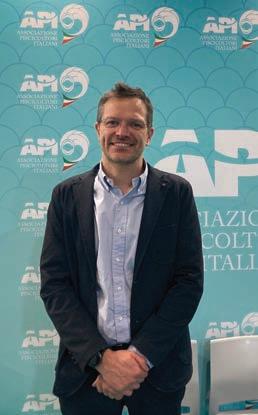
Matteo Leonardi, the president of the Italian fish farmers’ association, has to juggle immediate challenges while simultaneously addressing strategic objectives.
also set the stage for a diversified production that includes rainbow trout, brown trout, and Arctic char.
A major hurdle discussed was the restrictive regulatory framework governing marine aquaculture. While inland, freshwater production remains robust, Mr Leonardi says marine sites are hampered by a scarcity of licenses—only 20 exist, with 11 concentrated in a single town. This bottleneck underscores the need for reform
and more accessible pathways for expansion. Mr Leonardi is optimistic about leveraging EU projects to drive regulatory changes on a broader scale. By uniting stakeholders across member states, the organisation aims to tackle the fragmentation in policies that currently pits local, regional, and national authorities against each other—one of several initiatives the president is pushing to steer Italian finfish aquaculture in an economically sustainable direction.

DigiSafeCage—A digital revolution unfolds in the fish farming sector
Artificial intelligence, the Internet of Things (IoT), smart sensors, and risk prediction tools have the potential to change the aquaculture industry to make it more productive and environmentally friendly.

Traditional sea cages for growing fish can be equipped with sensors that monitor potential vulnerabilities and flag them before they become a threat thereby reducing the risk of irreversible damage and escapes.
The open sea offers vast opportunities for sustainable fish farming, but it also presents numerous challenges. Extreme weather, structural failures, and environmental threats lead to economic losses, fish escapes, and longterm ecological damage. Recent storms like the 2024 cold drop off the coast of Valencia, or Gloria, in eastern Spain and southern France in 2020, have shown the vulnerability of offshore cages, with production losses of up to 53 among species such as gilthead seabream.
In response to these challenges, DigiSafeCage emerges as a technological breakthrough designed to fortify aquaculture infrastructure against unpredictable marine conditions. Led by the Centro Tecnológico Naval y del Mar (CTN) and supported by NextGeneration
EU funds, this initiative combines AI, IoT sensors, and a digital twin model to monitor and predict risks in real-time. By employing big data, predictive analytics, and automated alerts, DigiSafeCage offers fish farmers the ability to anticipate problems before they occur, minimising financial losses while enhancing environmental sustainability. The project’s success is rooted in collaborative innovation, involving aquaculture companies, research institutions, and technology providers and is a good example of smart aquaculture systems under development in different countries.
Offshore aquaculture is a delicate balancing act between human ingenuity and the forces of nature.
While fish farming in open waters presents a sustainable way to meet global seafood demand, it also exposes operations to the unpredictability of the sea. High waves, strong currents, and shifting temperatures create an environment where infrastructure is constantly tested. The consequences of failure can be catastrophic: entire cages can collapse, fish stocks can escape, and farms can suffer financial setbacks from which recovery is slow and costly. The storms of recent years have made these risks abundantly clear. When the 2024 cold drop and the storm Gloria in 2020 swept across the Mediterranean, they left a trail of destruction in their wake. Offshore aquaculture suffered severe damage, with production losses reaching as high as 53 in gilthead seabream farms. These events underscored a troubling reality: traditional methods of monitoring and maintaining
fish cages are insufficient against the increasing intensity of extreme weather events.
Traditionally, fish farmers have relied on manual inspections, physical checks, and reactive maintenance to ensure the stability of their cages. This approach leaves farms vulnerable, as problems are often identified only after significant damage has already occurred. A net that debilitates over time, a rope that loosens with repeated strain, or a sudden spike in water temperature—these are risks that demand constant surveillance and instant responses, something that conventional methods struggle to provide. DigiSafeCage was born out of a necessity for change, a recognition that aquaculture cannot remain at the will of nature. Instead, it must harness technology to anticipate challenges before they escalate.

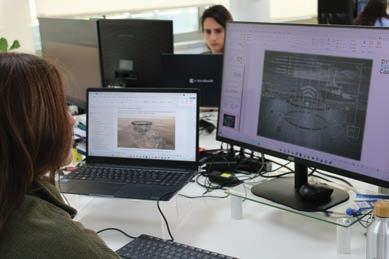
By merging artificial intelligence, IoT (hardware attached to or integrated into devices) sensors, and predictive analytics, the project equips fish farmers with the tools to foresee and prevent disasters rather than simply respond to them. As the industry faces mounting environmental and economic pressures, the need for smart aquaculture has never been greater.
At the core of DigiSafeCage lies its digital twin technology, an innovative system that creates a real-time virtual replica of a fish cage. This digital counterpart is not merely a static model; it replicates the behaviour and conditions of the actual cage, constantly updating as new data flows in from a network of advanced sensors. Every change in water movement, every minor shift in cage structure,
and every change in environmental parameters is recorded, analysed, and interpreted by artificial intelligence algorithms. The digital twin serves as an early warning system, detecting even the slightest irregularities in the structure or surroundings. It does not wait for a problem to become visible to the human eye. Instead, it identifies rising tensions in mooring lines, signs of net fatigue, and pressure points that could lead to structural failure. By forecasting these vulnerabilities, the system enables operators to intervene before an issue turns into a crisis.
Noelia Ortega, CEO of CTN, explains how this real-time technology is a game changer for the industry. “Before, fish farmers had to rely on physical inspections, which are not only time-consuming but also limited in scope. With DigiSafeCage, they receive continuous, real-time insights into their infrastructure, allowing them to act immediately rather
belong, competing with native species for resources and, in some cases, mixing with wild populations. This can weaken genetic diversity, introduce diseases, and disrupt fragile food chains. From an economic standpoint, fish escapes represent one of the most significant losses an aquaculture farm can endure. A single net failure can release thousands of fish into the open ocean, wiping out months of work and investment in the blink of an eye. The costs of such events are not limited to lost stock. Companies face reputational damage, legal liabilities, and regulatory fines, all of which can cripple operations.
than reactively.” Beyond structural monitoring, the system also plays a crucial role in environmental assessment. Offshore farms exist within dynamic marine ecosystems, where conditions can change unexpectedly. DigiSafeCage tracks water temperature fluctuations, wave intensity, and even the potential onset of harmful algal blooms. These insights help farmers make critical decisions about feeding schedules, stock management, and emergency protocols, ensuring that their fish remain in optimal health and safety conditions.
The escape of farmed fish into the wild is not just a financial setback for aquaculture companies—it is an ecological crisis. When farmed fish breach their enclosures, they enter marine ecosystems where they do not
According to José Luis, Aquaculture Manager at CTN, these risks can be mitigated—if not eliminated—through predictive technology. “Most net failures don’t happen suddenly. They start with small, unnoticed weaknesses that worsen over time. DigiSafeCage detects these vulnerabilities before they lead to catastrophic failures, allowing farms to reinforce their enclosures before it’s too late.” With its ability to assess the wear and tear on nets, monitor mooring line stability, and anticipate structural failures, the technology acts as a safeguard for both industry and marine ecosystems. By preventing escapes, it ensures that fish farmers can operate responsibly while maintaining the integrity of wild fisheries.
DigiSafeCage is not just a tool for preventing financial and structural losses; it is also a powerful instrument for enhancing the sustainability of aquaculture. The project leverages technology to reduce waste, optimise efficiency,

and protect the natural environment. The reduction of unnecessary repairs and emergency interventions translates into a lower carbon footprint, as boats no longer need to make frequent trips for inspections and emergency fixes. Additionally, by improving fish welfare through environmental monitoring, the system helps to reduce mortality rates and optimize feed conversion, making farms more efficient and reducing the strain on marine resources.
DigiSafeCage’s success is not the result of a single research team working in isolation. Instead, it is the product of extensive collaboration between leading aquaculture firms such as CULMAREX and Piscifactorías Albaladejo, as well as research organizations like CTAQUA and ANFACO-CECOPESCA. Their
input has been critical in refining the system, ensuring that it meets the practical needs of fish farmers while maintaining scientific rigour.
Tools developed for smart aquaculture can be deployed elsewhere too
As DigiSafeCage moves forward, its potential applications continue to grow. While it was initially designed for offshore aquaculture, its technology can be adapted for land-based recirculating aquaculture systems (RAS) and even other maritime industries. The same predictive monitoring systems that track cage integrity and environmental conditions can be applied to offshore wind farms, floating research stations, and marine conservation

The technology is based on a digital twin, a virtual model of the physical cage which renders time-consuming physical inspections of the cage obsolete thanks to the sensors which monitor the cage and the surrounding environment.
projects. The implications extend far beyond aquaculture, offering new possibilities for ocean-based industries that rely on infrastructure stability and environmental
awareness and thus securing the future of the blue economy.
Ixai Salvo, Eurofish, ixai@eurofish.dk
A Spanish project, RheoNet, mixes worn-down nets with asphalt to make durable roads
Old nets are being given a new life as an ingredient in road building material by researchers at the University of Salamanca. The aim is to reduce discarding of nets at sea by incentivising fishers and to use the nets for something worthwhile.
The roads of Zamora stretch across fields of grain, far from the cries of seagulls and the scent of salt in the air. Yet today, they bear the traces of the sea, as worn-out fishing nets find a second life beneath the wheels of passing trucks. What was once destined for the ocean floor as abandoned, lost, or discarded fishing gear (ALDFG) is now being repurposed into something unexpected: a key ingredient in
the construction of durable and sustainable roads. Each year, an estimated 640,000 tons of fishing gear are lost or discarded worldwide, making up 10 of marine plastic pollution. These ghost nets continue to trap marine life, break down into microplastics, and disrupt fragile ecosystems. The challenge of collecting, recycling, and repurposing these materials remains a major environmental and economic issue.
Enter RheoNet, an award-winning project led by the University of Salamanca (USAL) and funded by Next-Generation EU. Under the direction of Diana Movilla Quesada, this initiative seeks to bridge two unlikely industries— fishing and road construction— by transforming discarded nylon fishing nets into an innovative asphalt additive. The result? Stronger, longer-lasting roads and a sustainable solution to

Part of a fishing net washed up on a beach. When discarded, lost, or abandoned at sea fishing nets can continue to trap and kill marine creatures to no useful purpose.
marine waste. Recognised at the Rethink the Game Forum—an event organized by BMW España and Real Madrid—RheoNet is more than just a technological breakthrough; it is a model for the circular economy, proving that waste from one sector can become a valuable resource in another.
After years of service fishing nets become frayed and torn beyond repair, and are often unceremoniously discarded, their usefulness spent. Some will be properly collected; others, lost in storms or abandoned in the deep, become ghost nets, drifting with the currents and capturing marine life long after their intended purpose has faded. Each year, an estimated 2 of all fishing gear (around 640 thousand tons) are lost or discarded worldwide. This number might not seem much, but it comprises 2,963 km2 of gillnets, 75,049 km2 of purse seine nets, 218 km2 of trawl nets, 739,583 km of longline mainlines, and more than 25 million pots and traps that are lost to the ocean annually.1 These ghost nets, lines and traps continue to capture marine life, break down into microplastics, and disrupt fragile ecosystems. The challenge of collecting, recycling and repurposing these materials remains a major environmental and economic issue.
For fishermen, the choices are limited. Recycling is costly, and ports lack the necessary infrastructure to manage worn-out gear. Some nets are stored indefinitely, stacked in forgotten corners of docks and warehouses, while others are cast aside, not


Nets waiting to be processed at the Zamora campus of the University of
nets are gathered in collaboration with the Virgen de la Guía fishermen’s guild. Support from fishers is crucial for the collection of nets.
out of carelessness, but out of necessity. The sea reclaims them in ways no one intended. It is here, at this intersection of tradition and sustainability, that RheoNet offers a new path—one where fishermen do not discard their tools but pass them forward. Instead of fading into the sea, these nets will now become part of the roads that connect the country.
In the laboratories of the Escuela Politécnica Superior of Zamora, deep in the Castilian plateau of Spain, a different kind of transformation takes place. Here, discarded nylon fishing nets are ground into fine particles, blended into asphalt mixtures, and tested for durability. The
fibres that once flexed with the tides now bind with bitumen, forming a resilient, high-performance pavement capable of withstanding the relentless passage of trucks and time. This innovative approach is the result of years of dedicated research by the RheoNet team, composed of experts in civil engineering, materials science, and sustainability. The initiative is led by Dr Diana Movilla Quesada at the University of Salamanca with contributions from Aitor Cristiam Raposeiras Ramos, Ana Belén Ramos Gavilán, María Ascensión Rodríguez Esteban, and María Almudena Frechilla Alonso. The project also benefits from international collaboration with Professor Manuel Lagos Varas from the Universidad Austral de Chile and the work of Silvana Aparicio Ferrero, a civil engineering graduate student,
whose thesis was developed within this research framework.
The process unfolds in three steps:
• Recovery and collection—In partnership with the “Virgen de la Guía” fishermen’s guild in Ribadesella (Asturias), used nets are gathered, inspected, and sorted for recycling.
• Shredding and preparation—The nets are mechanically processed, reduced to a fine powder that retains the strength and flexibility of the original material.
• Integration into road construction—Mixed into asphalt, these fibres enhance the density and durability of the pavement, reducing the need for fossil-fuel-based polymers.
But turning nets into road is no simple task. Nylon’s chemistry
1 Kelsey Richardson et al. ,Global estimates of fishing gear lost to the ocean each year.Sci. Adv.8,eabq0135(2022).DOI:10.1126/sciadv.abq0135


The nets are sorted and those that are identified as suitable are shredded to a fine powder (right). The powder retains the strength and flexibility of the original material.
resists fusion with bitumen, requiring meticulous testing to ensure compatibility. Heat sensitivity must be controlled, lest the material degrade before it can do its work. Not all nets qualify—monofilament nylon, used widely in trawl and gillnets, proves most effective, while polyethylene and polypropylene struggle to bind. Still, the results speak for themselves. Roads infused with RheoNet-modified asphalt exhibit greater resistance to deformation, improved longevity, and a reduced environmental footprint.
Every net repurposed means one less net strangling a reef, trapping marine life, or breaking up into microplastic. This reduction of marine plastic waste is the main environmental gain of the project. Additionally, RheoNet contributes to a greener infrastructure industry by replacing fossil fuel-based road polymers. This replacement not only lowers carbon emissions but also makes longer lasting
roads. This more durable asphalt means fewer repairs, less material use, and a reduced environmental impact over time. Therefore, an economic advantage is linked to this change as stronger, costefficient roads mean that governments benefit from materials that last longer and require less maintenance. Also, it generates a benefit for fishers, as they can contribute with their nets to a circular economy solution, cutting costs and avoiding the burden of disposal fees.
Fishermen who once viewed their old nets as a costly inconvenience now see them as a contribution to something greater. At the heart of this shift is the Cofradía of “Virgen de la Guía”, led by Patrón Mayor Manuel Buenaga Palmero. His deep commitment to both the ocean and its people has turned this collaboration into a success story of local engagement and sustainable transition. Yet, involving the fishing community
is no simple matter. Practical challenges abound involve creating an efficient collection system that does not disrupt daily operations, providing incentives that make participation economically viable and on top of everything, ensuring trust and transparency in how the nets are used. What began as a small-scale effort has now gained national recognition. With continued support, it could expand beyond the Autonomous region of Asturias, involving coastal communities across Spain and Europe.
The next phase of the project will see RheoNet asphalt tested under actual road traffic conditions to validate its performance beyond controlled environments. Together with this, collaborations with construction firms and public infrastructure planners will set up industry partnerships that will determine how this technology can be adopted on a wider scale. Moreover, RheoNet will have to align with national and European sustainability initiatives to ensure its acceptance in public work projects.
If fishing nets can strengthen asphalt, what other possibilities exist? RheoNet polymers could be adapted for use in building foundations, bridges, and erosion control systems. Also, the push for sustainable materials in car manufacturing could open new doors for the use of net polymers. And finally, RheoNet could find a spot in the competitive textile industry providing eco-friendly fashion and furniture, that will have the potential of integrating repurposed fishing gear into diverse industries. Expansion will not only focus on Spain, but also on Europe and possibly Latin America too, says Dr Movilla Quesada, as the research started originally in Chile with discarded nets from the salmon industry. If the challenges can be addressed, the conversion of nets into roads and other infrastructure would seem a win-win situation with benefits for both the environment and for economies.
Ixai Salvo, Eurofish, ixai@eurofish.dk
Hamachi,
Although many fish experts consider species of the genus Seriola to be among the most edible fish in the world, they are still relatively unknown to most consumers (and perhaps even to some fishmongers!). More education is needed, as these excellent farmed fish have recently started to be offered for sale in this country.
Not all fish species contain the same amount of valuable nutrients. The content of easily digestible proteins or omega-3 rich fats, essential vitamins and minerals varies from species to species and is often subject to seasonal fluctuations. However, in this respect, the species of the Carangidae genus Seriola are hardly problematic, because their nutritional and health value and their palatability are clearly superior to those of many other fish. The Seriola species, which are commonly traded on international markets as greater amberjack, kingfish, and amberjack or hamachi, kanpachi and hiramasa, are undoubtedly among the best that the oceans have to offer.
The genus Seriola currently includes nine species, all of which resemble tuna due to their streamlined bodies. Like tuna, they are also fast swimmers and prefer to hunt for prey in the upper layers of the water along tropical and subtropical coasts, down to depths of around
Scientific name Trade name:
50 metres, sometimes down to 200 metres, in groups or shoals. They feed mainly on smaller fish such as sand lances, sardines, anchovies, mackerel, Atlantic horse mackerel and Atlantic saury, as well as squid and other invertebrates. Almost all Seriola species grow to at least one metre, some to 1.5–2.5 metres, and weigh up to 100 kg. However, the average sizes sold on the market are usually between 3.5 and 5.5 kilograms, occasionally more.
Although almost all nine species are equally suitable as edible fish, the global fish trade focuses mainly on three to four species sold under the same or at least similar names, which often makes it difficult to distinguish between them:
Nomenclatural differentiation is further complicated by the names, which depend on the size of the fish. Japanese amberjack, the most commercially important species of the genus Seriola on the world market, which is found in the Pacific Northwest between
Seriola quinqueradiata Japanese amberjack, yellowtail, hamachi
Seriola lalandi Yellowtail kingfish, yellowtail amberjack, great amberjack, hiramasa
Seriola dumerili Greater yellowtail, greater amberjack, yellow trevally, amberjack, kampachi
Seriola rivoliana Longfin yellowtail, silvercoat jack, kampachi
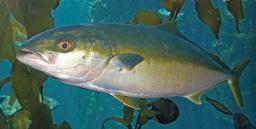
Yellowtail amberjack, or hiramasa (Seriola lalandi ), prefers warmer waters (18–24 °C) in the Pacific and Indian Oceans, but is also expanding into cooler regions of the Southern Hemisphere and North Pacific.
Japan and Hawaii, can grow up to 1.5 metres in size and weigh 40 kg. Fish up to 50 g are sold as mojaco, those up to 5,000 g as hamachi and those over 5,000 g as buri.
Demand is met by both fishery catches and aquaculture, which currently still contribute approximately equal amounts. Accurate comparisons are difficult because not only are yellowtails regularly caught, but are also popular with sport fishers worldwide, and the recording of these numbers is very patchy. Estimates suggest that the total annual landings fluctuate around 200,000 tonnes, of which Japanese amberjack alone accounts for around 120,000 tonnes. In addition, there
is aquaculture production, which is currently between 140,000 and 160,000 tonnes. The main species here is also the Japanese amberjack Seriola quinqueradiata, which accounts for almost 80 of global aquaculture production. This has implications for natural resources, as fishing and aquaculture are more closely linked than is often thought. While species such as Seriola lalandi and S. dumerili are increasingly being bred in hatcheries, Japanese amberjack aquaculture production continues to be based mainly on natural resources. During the spawning season, many millions of larvae measuring just 15 mm in size are caught each year in fine mesh nets and reared in specialised farms to a size of 10 cm for stocking. The demand for wild larvae is huge, because mortality is extremely high at this
stage of life. Tiny larvae need a balanced, nutrient-rich live food to start with and have to be sorted several times, otherwise the losses caused by cannibalism become too great. Despite all precautions, rarely more than 4–5 on average survive this early phase of rearing, and the incidence of deformities is high. As Japan, the main producer of Japanese amberjack, does not have enough larvae of its own to meet the needs of its farms, the country imports a further 20 million larvae each year, mainly from South Korea and Vietnam. Catching such large numbers of larvae naturally weakens the recovery of wild populations. Nevertheless, the biomass of this yellowtail species, which is one of Japan’s most important fishery resources and accounts for almost 60 of the Asian country’s aquaculture production, has tripled in the last 20 years to more than 300,000 tonnes.
In Japan, where Seriola species are known by more than 20 different names, aquaculture of these fish has a very long tradition. The first farms, where wildcaught juveniles were fattened in primitive enclosures, were established in Kagawa Prefecture in 1927. Due to deteriorating water quality, operations were temporarily suspended, but revived in the 1940s, reaching an all-time high of 170,000 tonnes in 1995. Since then, production has stabilised at between 100,000 and 120,000 tonnes per year. Although Seriola species are now farmed in many countries, Japan is still the largest producer and arguably the most important market for these fish, which, due to their exceptional quality, are attracting great economic interest from investors worldwide. Currently, Seriola species are farmed in Australia, Europe, the United States, Mexico, South Africa, Saudi Arabia
and the United Arab Emirates, to name just a few major producing countries. There are also numerous research and development projects related to Seriola cultures, including projects in New Zealand, Argentina and Chile.
In addition to Seriola quinqueradiata, the preferred species for aquaculture are the yellowtail or kingfish species Seriola lalandi and Seriola dumerili. This is probably largely due to the possibility of producing fish for stocking in hatcheries, which makes rearing independent of wild-caught larvae. Thanks to sophisticated incubation and rearing technologies, larvae and juvenile fish are now available year-round outside the regular spawning season. The majority of Seriola production takes place in net cage facilities in the sea, either anchored near the coast or in submersible nets in the open sea. While these simple farming methods work, they come with the well-known problems of open systems. The still common practice of taking fish from natural resources is weakening wild populations. There is an ongoing debate on the dangers of escapes. Conventional feeds range from whole or minced fish (trash fish) to simple compound feeds and extruded, formulated pellets, which currently only account for about 40 of the total spectrum. Almost all quinqueradiata aquaculture is based on trash fish, which puts a strain on many small fish stocks in some regions and leads to an increase in procurement prices. To produce one kilo of yellowtail, 7 to 8 kilos of raw wild fish are used as feed. Even with the preferred feed of chopped frozen sardines, the feed accounts for about half of the production costs. The
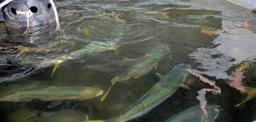
transition to extruded pellets is difficult because fish prefer more than three kilograms of raw fish, grow poorly on dry food, and do not reach the desired quality.
Diseases and parasites that affect fish stocks are a problem that is difficult to control in open and unprotected net pens in the sea. Parasitic flatworms (e.g. Benedenia seriolae, Zeuxapta seriolae) can infect the skin and gills of fish, reducing their appetite and slowing growth. Extreme parasite infestations can lead to a loss of osmotic control (skin flukes) or anoxia (gill flukes), which ultimately can even cause the death of the fish. Such risks are one of the reasons why yellowtail kingfish aquaculture is increasingly being moved to land-based facilities, mostly recirculating aquaculture systems (RAS). In such facilities, fish farming conditions can be better controlled. In addition, RAS can operate in regions that would otherwise be unsuitable due to climate.
Seriola species are particularly favourable for indoor RAS production. Studies have shown that these fish can be kept at high densities of up to 80 kg/m3 without showing signs of stress or suppressed growth. Provided the conditions are optimal, of course. The tendency of some other fish species to develop an off-flavour typical of RAS is not
quite as pronounced in Seriola However, land-based production is not without risk either, because even a simple power outage can disrupt oxygen supply and water exchange, despite immediate alarms, backups and redundant systems, posing a serious risk to fish stocks.
Probably the most common Seriola species in the European RAS is the yellowtail kingfish (S. lalandi), which is already farmed in the Netherlands, Denmark, Norway, and even Germany. Lalandi is an extremely fastgrowing species, which can weigh up to 2.5 kilograms in its first year of life. This means that it grows two to three times faster than Mediterranean fish such as gilt-head bream or sea bass. Lalandi also has the advantage of being easier to propagate and grow than other Seriola species. The maturation of the gonads does not necessarily have to be induced by hormones and no sedatives are required for stripping (the handling of large spawners is often difficult). Lalandi larvae are less aggressive and cannibalism is less common.
In Europe, two RAS producers are particularly famous for breeding and rearing S. lalandi: Kingfish Zeeland (NL) and Nordic
Aquafarms Group (N). Kingfish Zeeland’s marine recirculation facility is located in the middle of a Natura 2000 protected area in the estuary of the Eastern Scheldt in the Dutch province of Zeeland. The company‘s green strategy is fully focused on environmental protection and sustainability. Kingfish Zeeland has mastered all the stages of farming from hatching to market-ready fish, thus completely closing the Lalandi life cycle. The water in the system is sterilised with UV and ozone, and no antibiotics or vaccines are used. The energy is 100 renewable (wind, solar and biogas). The nutrients in the runoff water serve as fertiliser for Salicornia plants and algae cultures. This concept is recognised by the ASC, BAP and FotS certificates, and the Good Fish Foundation recommends the kingfish produced as a ‘good choice’.
As a result of the success of the production, the Kingfish Company has increased the capacity of its RAS facilities from 1,500 to 3,500 tonnes per year and has built a processing plant directly connected to the farm. There, the fish are electrocuted, cooled to 1–2 °C, gutted, sorted, packaged and frozen. This means that fish harvested at 4 a.m. can be shipped to customers in Europe, the Middle East and North America on the same day. At the end of 2021, the company’s US subsidiary, Kingfish Maine, received a state permit to build a RAS with an annual capacity of 8,500 tonnes in Jonesport, Maine. The necessary land has already been purchased and construction will start as soon as financing is secured.
Nordic Aquafarms Group, Europe’s second largest producer of kingfish, based in Norway, also raises its own fish on RAS farms. Nordic
Aquafarms Europe brings together Norway’s Fredrikstad Seafood and Denmark’s Sashimi Royal with the Maximus hatchery. In April 2022, the company announced its intention to move away from salmon farming and focus exclusively on land-based yellowtail kingfish production. Nordic Kingfish has been producing yellowtails in Hanstholm, Denmark, since 2017 and has its own nursery and hatchery in Limfjord. Now, on the outskirts of Fredrikstad, south of Oslo, the RAS is also being adapted to a new fish species. The Group expects to increase profitability by switching from salmon to Seriola lalandi. Europe remains the main market.
Seriola is now gaining increasing attention in many countries. In Chile, the possibility of farming lalandi is being explored within the framework of the Programa de Diversificación de la Acuicultura Chilena (PDACH). At the beginning of 2025, the City Council of El Puerto de Santa Maria (Cadiz, Spain) gave permission for the construction of a yellowtail RAS in the port area, expected to produce up to 450 tonnes per year. A major project by Open Ocean Andalusia, which includes a 15,000 tonne marine farm 6 miles off the Spanish coast, a hatchery and a 20,000 tonne feed mill, is expected to reach full capacity by 2027. Investors are said to have already launched similar initiatives in Mexico, Oman, Brazil and Mauritius. However, in this case, the target species is not Lalandi, but Seriola dumerili, which is the only species of this genus to be found in the Mediterranean Sea. The first attempts to cultivate Dumerili in Spain and Italy were made in the 1980s, but were abandoned due to the still unreliable supply of fish at that time. In recent years, interest has grown again. Dumerili is considered to be one of the most important species for diversifying commercial fish
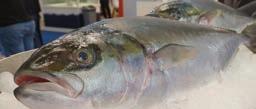
Due to the increasing aquaculture production of Seriola lalandi in the European RAS, this fish is now often offered at fish fairs such as those in Bremen or Barcelona.
production in the Mediterranean. Malta, Italy, Spain, Greece, Croatia and Turkey have launched research and development programmes for the aquaculture of this species. Dumerili is also part of the EUfunded research project DIVERSIFY, which identifies fish species with potential for development in the EU aquaculture industry.
Seriola species are worthwhile candidates for the development of aquaculture production due to their high market value, increasing demand and the enormous versatility of high-value edible fish with a wide potential for processing and adding value. Currently, the main product is still fresh whole fish (HOG). However, the fish can also be marketed as fillets, steaks, portions or as processed convenience products. The firm yet delicate white meat has a mild, pure and slightly mineral flavour. Seriola species are suitable for all typical fish dishes and tolerate strong spices and flavours ranging from chilli, garlic and ginger to soy, lemongrass, rosemary and thyme. However, the excellent quality of this fish is best when used raw as sushi and sashimi. In Japan, the country where these types of food originated, many people consider yellowtail to be the best fish in the world for sashimi. Especially if the fillets have a fat content of around 10 percent (both low and high fat are not suitable for sashimi). In addition to preparation in hot and
cold dishes or sushi bars, there are also a number of Mediterraneaninspired ready-made products that are ideal for supermarket shelves. These include grated Sicilian bottarga from amberjack, smoked amberjack, which tastes excellent as fish carpaccio, and ready-made amberjack sauce, which goes well with a dash of olive oil on toasted bread, with pasta and with meat and fish dishes.
In 2007, an article ‘Yellowtail Kingfish Culture – Opportunities and Problems’ in the World Aquaculture Society predicted a bright future for Seriola species. It called them ‘emerging species in marine aquaculture’. Although these fish are indeed being farmed in increasing numbers today, yellowtail aquaculture is still at an early stage, almost two decades later, compared to the previous optimistic forecast. There are several reasons for this. Hatching and rearing technologies—both in the field and in RAS—have been improved but are still far from fully developed. Although Seriola is already well known in some markets, there is still a strong need for education elsewhere, especially as the relatively high price level of fish probably deters many ‘uninformed’ buyers. Those who are not familiar with the fish are also less likely to dare to prepare it. Therefore, better consumer education and targeted advertising are needed to increase demand and production from aquaculture.
Many people associate the trade in live fish with Asian markets, where these products are considered luxury foods. In reality, however, the live fish trade is much broader, as it also includes fish for stocking in aquaculture or for restocking wild stocks. A particularly lucrative area in this market segment is ornamental fish for aquariums, which generates billions of euros in sales every year.
In front of every good restaurant in Asia, there are aquariums from which guests can choose exactly the fish that the kitchen will then prepare for them. It does not get any fresher than this. Less well-off customers can also buy live fish and seafood at one of the countless daily markets that can be found in every larger town. While the trade and catering industries in the rich western industrialized countries have almost completely abandoned the sale of live fish— not least under pressure from legal requirements and animal welfare demands—this tradition is still maintained in other regions of the world. Nevertheless, the live fish trade still plays a larger and more important role here than is sometimes assumed. Mussels and oysters are mainly sold fresh, and despite the increasing popularity of HPP lobster, live lobsters are still available. The trade in juvenile fish for stocking purposes is flourishing throughout Europe, be it trout, char, or carp for aquaculture and the many fishing ponds, or eels and other wild fish to support and preserve threatened natural populations. The demand for live aquatic animals is particularly high in the aquarium industry. In the past, the demand for private and public aquariums was mainly limited to freshwater species such as guppies, scalars, and neon tetras. Today, almost half of the
industry’s turnover comes from marine fish. And the trend is rising sharply. In total, more than 2,000 species are traded worldwide for aquarium purposes. Mainly fish, but also shrimps, molluscs, and echinoderms. Moreover, despite all the criticism, a bizarre trend is spreading in European spas and medical care facilities—one that has washed over from Asia: Kangal fish (Garra rufa) that gently nibble on calluses dead skin flakes from feet worn down by daily life. Since then, the demand for the small, reddish suckermouth fish has increased dramatically.
Due to this enormous diversity and breadth, the financial value of the live fish trade is difficult to determine. Global trade is inadequately monitored. Export figures are unavailable or unreliable in most countries. Often, the volume of trade can only be estimated approximately. For many species that are already threatened and actually require strict regulation, the values estimated are probably far too low. This particularly applies to the trade in live reef fish (LRFF), which includes the very popular and valuable grouper species in Asia, whose primary catch value is officially stated at only 300 to 400 million US dollars. Realistically, a multiple of this value is likely. Especially when accounting for the ecological
damage caused. A large number of groupers and other fish species are lost during catching and then on the risky route to the customers. It is assumed that more than half of the groupers die before reaching the market. In this respect, the official estimates, which assume a total value of around 2.8 billion US dollars for the global trade in live fish and seafood at the producer level, are probably significantly underestimated. The goods are sold on the end markets for many times this value.
The centre of the trade in live edible fish is in Hong Kong. Other important markets are Singapore, mainland China, and Taiwan. The main suppliers of wild-caught fish are Indonesia, Thailand, Malaysia, Australia, and Vietnam. A growing proportion of the grouper traded live now comes from aquaculture, with China and in particular Taiwan and Malaysia being the leaders. However, for many customers who still prefer wild fish, this is not a full substitute. In any case, farming does little to protect wild groupers because a significant proportion of farming is based on wild stocks. Closed life-cycle aquaculture, in which eggs are collected, the fry are reared, and the fish are fed to market size, currently only accounts for 10 to 15 per cent of the relevant market.

Some grouper species are already being successfully reproduced in some Asian countries and raised in aquaculture in a closed lifecycle from the egg onwards.
Farmers are struggling with high mortality rates, various diseases, and a lack of suitable feed.
The live fish trade is a lucrative business that allows for high profit margins, but these are very unevenly distributed between fishers, middlemen, and sellers. While fishers usually have to make do with just a few dollars per kilogram, depend-

Capture-based aquaculture, in which young animals are caught in the wild and brought to market size in net enclosures, is still typical for grouper farming.
ing on the size of the fish and the time of year (prices are much higher on Asian markets during holidays), even for valuable and sought-after grouper species, the wholesale price is between ten and sixty US dollars, and the retail price can even get up to 180 dollars. On average, the sale of live groupers brings the fisher around 6,000 US dollars per tonne, while the retailer earns at least ten times that amount. They
often justify this unequal business with the argument that they also bear the risk of loss when transporting and selling the sensitive fish. In fact, the fisher bears far greater risks because the often brutal fishing methods destroy parts of the reef, kill other fish that could be caught for food, and cause other serious damage to the marine ecosystem. The long-term consequences are considerable, because very young
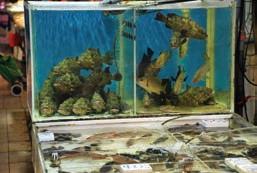
groupers that have never reproduced are often caught, decimating local spawning stocks, and potential food for other reef organisms is lost.
The main cause of this destruction is the practice of reef fishing with sodium cyanide (NaCN), a dangerous but cheap and highly effective poison. Cyanide fishing involves spraying a poison solution
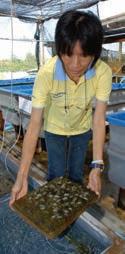
In order to repopulate plundered ecosystems, state hatcheries often raise new stock, such as giant Tridacna clams.
from squirt bottles onto target fish hiding between coral branches. The poison stuns the fish, making them easier to catch, and they usually recover after a few minutes. This fishing method has spread across much of the Indo-Pacific since the 1960s. Although cyanide fishing is now banned in the Philippines, Indonesia, and elsewhere,

those
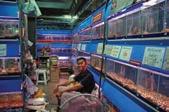
The demand for ornamental fish for aquariums is very high worldwide. In addition to the traditional freshwater species, marine species are becoming increasingly important.
many reef fish are reportedly still caught using this method, which is dangerous to humans and animals. In the Philippines alone, the amount of cyanide traded each year is said to be 170,000 kg, but it is impossible to determine exact figures. The risk of fisher being caught in this illegal practice is extremely low, as the fishing areas are spread out over a wide area of the sea, and the inspectors often turn a blind eye or even make deals with the fishers and pocket a share of the profits. Perhaps the problem could be contained with a rapid test that would enable buyers to detect the use of cyanide in a water sample from the transport container. However, this would require that they are interested in

Guppies are relatively easy to breed, but specialized breeding companies produce particularly beautiful and attractive varieties.
such controls and actually want to stop this destructive practice. In the long term, this could perhaps even lead to an internationally recognized cyanide-free certification.
The extent of the damage caused by fishing is much greater
The use of explosives in reef fishing is even more harmful to the environment than cyanide because this fishing method not only destroys fish and other living creatures but also the coral structures that have often taken decades to grow. This method is also completely ineffective because very few fish survive the explosions and can actually be
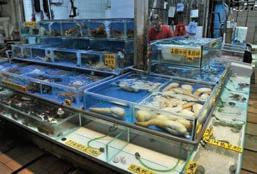

The breeding of fighting fish (Betta splendens), also known as Siamese fighting fish, is a particularly complex and laborious business.
sold alive. Even weak explosive devices can irreversibly destroy corals within a radius of three to ten metres. The economic consequences of this brutal fishing method are fatal because it results in the loss of entire ecosystems and, of course, valuable habitat for the fish community, which is part of the food supply for the inhabitants of these areas. When reefs suffer, fisheries are proven to deteriorate. Studies show that just 400 m of healthy reef can feed 800 people, while the same area of damaged reef can only feed a quarter of that number. It is estimated that in the Indo-Pacific region, coral reefs have already been damaged by explosives in almost half of the countries,
including Guam, Indonesia, Malaysia, and Thailand. Unfortunately, the practice has now spread to Africa, including Tanzania and other countries bordering the Indian Ocean. The Global Coral Reef Monitoring Network estimates that 25 of the world’s reefs are damaged, and another third are at acute risk. According to the Network, the live fish trade is one of the main causes of this alarming ecological trend.
Live fishing for reef fish has expanded enormously since the 1990s. The number of players involved is growing because the interest in live fish in countries where exorbitant prices are paid for this high-quality commodity


To prevent losses, male Betta fish are kept individually in tens of thousands of bottles, which makes water changes and feeding extremely laborious.
makes the market segment highly lucrative financially. In principle, it does not matter where the fish was caught. Unscrupulous fish buyers are constantly looking for new, unused reefs where they can exploit the coveted fish species without major problems or disruption. Bans and occasional controls are of little help because the industry is highly mobile and simply moves on as soon as the authorities in a country try to curb
the environmentally damaging fishing and enforce serious restrictions.
Regulatory attempts and controls have failed
There are many objections and reasons against this type of live fish trade. These include the destruction of nature and poor animal welfare, the introduction of foreign species and

possible diseases, and a lack of traceability along the supply chain. All efforts to better monitor the markets—from fishers to buyers and brokers to wholesalers and retailers, including the trade associations and government authorities involved—have done little to solve the problem. Catch quotas, bans on fishing for certain species, export controls, and size restrictions have made the trade in endangered reef species more difficult but have not stopped it. National controls on live fish catches have so far proven ineffective in most countries because the fishing locations are usually much too far away from the monitoring centres and responsible authorities. Some NGOs and environmental organizations now even believe that it may be better not to ban the trade in live fish completely because otherwise there is a risk that fishing using regular methods may become even stricter and more rigid. Despite the relatively poor pay, fishers generally receive about 2 to 4 times the price for live grouper as they would for the same fish freshly caught but dead.
To earn the same amount through ‘normal’ fishing, fishers would probably want to catch significantly more fish. A prerequisite for ecologically acceptable live fishing would, of course, be to avoid the use of cyanide and explosives in favour of sustainable net fishing methods.
Switching fishing methods to nets and traps would probably do more to save reef communities than attempts to completely eradicate the trade. In fact, international conservation groups have been working since 1984 to introduce net fishing as a less damaging alternative. Studies have shown that the long-term survival rate of net catches can be as high as 90, while only 10 of fish survive in cyanide fishing. The key to the success of all efforts, however, is once again the well-informed consumer, who makes a crucial contribution to protecting wild fish species and preserving nature and the environment. If consumers act sustainably and change their eating habits, the overexploitation of nature would very quickly
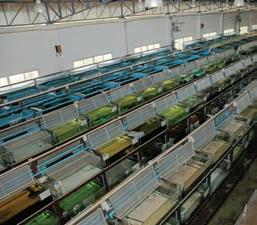
come to a halt. More restraint in the distribution of live fish would also make sense from a nature conservation perspective, as some imported species are threatened with extinction in their native habitat or are even protected by CITES. Others can become invasive in the new settlement area (e.g., the lionfish in the Caribbean) and displace native species or introduce dangerous diseases, such as Spring Viraemia Carp Virus (SVCV) and Koi Herpes Virus (KHV).
Even the love of nature can become a threat
Another economically important area of the live fish trade is ornamental fish, which are in demand by the millions for private and public aquariums. The EU countries and the USA are the world’s largest markets and single importers of ornamental fish. The size and extent of this market segment can only be estimated approximately. The primary value on the supplier side is typically estimated at a minimum of USD 1 billion. At the retail level, however, sales are likely to be well over USD 10 billion. This market is still dominated by freshwater species, which account for more than 60 of the industry’s turnover. In principle, 2,000 to 2,500 species of fish are suitable for the aquarium hobby, but the main business is limited to just around 30 species and species groups, primarily livebearers, neon tetras, zebra danios, goldfish, and discus fish. Guppies and neon tetras alone make up more than 25 of the market by volume and more than 14 by value.
Traditionally, freshwater ornamental fish have been bred and farmed in countries such as Thailand, Indonesia, Singapore, China (including Hong Kong), Malaysia, and Japan. However, in recent
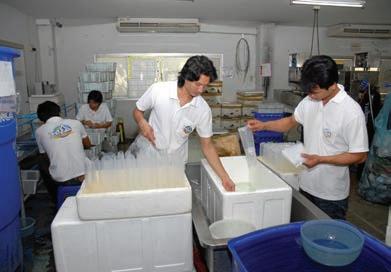
decades, production has increasingly shifted to countries closer to the markets where these fish are in demand. In Europe, for example, freshwater ornamental fish are bred for European consumers with great success in the Czech Republic, Belgium, and the Netherlands. Despite the higher labour costs, production is often more profitable than in Asia because the costs of packaging and transport are significantly lower.
As a result of significantly improved technology, marine aquaristics is also becoming increasingly important. Ever since blockbusters such as Finding Nemo made the colourful and charismatic marine fish popular, the industry has been booming with impressive growth rates. Although marine aquariums are still much more expensive and demanding and the fish require
more care than freshwater species, keeping marine fish as a hobby is becoming increasingly popular. This is once again paying off for suppliers because the retail value for a kilogram of coral reef fish intended for the aquarium trade is on average USD 500 to 1,800, while ‘normal marine fish’ intended for human consumption normally only fetch USD 6 to 20 per kilogram. This, of course, has consequences for procurement. While the majority of freshwater species today come from private and commercial breeding facilities, the proportion of wild-caught marine species is said to still be well over 90 per cent in terms of value. The majority of marine aquarium animals come from tropical oceans. Among other places, they come from the archipelagos of Indonesia, the Philippines, Sri Lanka, the Maldives, and the Central Pacific islands. Fish are also regularly imported from the Caribbean (e.g., Puerto Rico) and
the Red Sea. Every year, around 25 to 27 million reef animals are collected from the Hawaiian reefs alone and shipped for sale in the aquarium trade. The demand is not waning, as over 90 of these wild catches are said to not survive their first year in the aquarium.
With the boom in marine aquariums, many fish keepers have also developed the desire to create real mini ecosystems in glass tanks and thus bring a marine reef into their own home. Since then, not only marine fish have been in demand, but also invertebrates that live on marine reefs: hard and soft corals, crustaceans such as shrimps and hermit crabs, molluscs from snails to scallops, and echinoderms such as starfish and sea urchins. This market has also rapidly developed into a profitable business and has led to species-rich coral reefs being rigorously plundered. Manfred Klinkhardt
The discovery by UK scientists that scallops are attracted by LED lights has led to the development of a fishery that is both sustainable and delivers high product quality.
The seafood industry is undergoing a remarkable transformation as sustainability and environmental responsibility take centre stage. A breakthrough in scallop fishing, known as Disco Scallops, is challenging decades-old practices by replacing traditional dredging methods with an innovative approach that uses LED-lit pots. This novel technique, pioneered by Fishtek Marine and its research partners, offers a sustainable and economically viable alternative to conventional methods that are more damaging to marine habitats.
Traditional scallop fishing relies heavily on dredging—a method that involves dragging heavy, toothed metal sleds across the seabed to harvest scallops. Although this approach yields large quantities of scallops, it inflicts significant damage on marine ecosystems by disturbing the seafloor, destroying fragile habitats, and resulting in substantial bycatch. In the United Kingdom, for example, around 95 of scallops are caught using dredging, despite increasing concerns over its environmental repercussions. Alternative methods, such as hand-diving, have been explored, but they are limited by safety concerns, depth restrictions, and unfavourable weather conditions, making them
impractical for large-scale commercial operations.
In 2022, while trialling underwater lighting technology known as PotLights—originally designed to attract crabs and lobsters—a team of researchers led by Dr Rob Enever at Fishtek Marine, a UK engineering company focused on conservation, made an unexpected discovery. They observed that scallops, equipped with hundreds of tiny image-forming eyes, were attracted to the flashing LED lights and would swim into the modified pots. This serendipitous finding laid the foundation for what is now being hailed as the future of scallop fishing. Extensive field trials, supported by funding from organisations such as Natural England and the UK Seafood Innovation Fund, have refined the technology. Today, over 40 boats employ these specially designed pots to catch what are now branded as Disco Scallops, establishing a low-impact fishery that preserves marine ecosystems while providing economic benefits to coastal communities.
The process behind scallop potting with lights is both simple and effective. Modified pots, originally used for catching crabs and lobsters, are equipped with strategically placed LED lights that take advantage of scallops’ natural phototactic behaviour. When these lights are activated, the
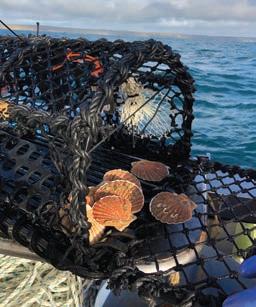
scallops are drawn to them and swim into the pots, where they remain until the fishing gear is hauled back to the surface. Unlike dredging, which scrapes and disturbs the seabed indiscriminately, this method is passive and highly selective, ensuring that only the intended species are captured and that the surrounding habitat is left largely undisturbed. In controlled experiments, researchers found that of the 518 scallops recorded, an overwhelming 99.6 were caught in pots fitted with lights. In fact, the most
effective configuration—a modified parlour pot equipped with LED lights—produced an average catch rate of 19 scallops per string per 24 hours, with some pots holding up to 24 scallops at a time.
The environmental advantages of this method are significant. By eliminating the need for dredging, the new approach prevents the extensive physical disruption of the seabed, protecting the biodiversity and integrity of marine habitats. This is particularly important in areas designated as
Marine Protected Areas (MPAs), where preserving the natural environment is paramount and dredging is strictly prohibited. Moreover, the energy requirements for scallop potting are considerably lower than those of dredging operations. Traditional dredging is not only destructive but also fuel-intensive, contributing to a larger carbon footprint. In contrast, scallop potting uses static gear that consumes far less energy, thereby supporting broader efforts to reduce greenhouse gas emissions within the seafood industry.
Economic and social benefits are also driving the adoption of this innovative fishing method. Many coastal communities have long depended on traditional crab and lobster fisheries, yet these industries face increasing challenges from regulatory changes, fluctuating market prices, and declining stocks. The introduction of potcaught scallops offers these communities a valuable opportunity to diversify their income streams. By integrating scallop potting into their existing fishing operations, fishermen can secure new revenue sources without the significant financial risks associated
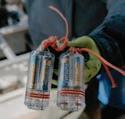
with adopting entirely new practices. Furthermore, as consumer demand for sustainably sourced seafood continues to rise, scallops caught using this method are poised to command premium prices—sometimes two to two and a half times higher than those for traditionally dredged scallops. This price premium is comparable to that of hand-dived scallops, which are celebrated for their environmental credentials despite being available in much more limited quantities.
The success of this method has not only attracted the attention of environmentalists and marine scientists but also spurred the formation of industry initiatives such as the Disco Scallop Collective. This collective, comprised of fishermen, seafood restaurateurs, and industry stakeholders, aims to promote the sustainable, high-quality scallops produced using LED-lit pots. High-profile chefs like Mitch Tonks, founder of the Rockfish restaurant group, have embraced Disco Scallops and incorporated them into their menus, describing them as “the scallops of the future.” Their endorsement highlights the dual appeal of the product—not only is it environmentally responsible, but it also meets the high standards of quality and taste demanded by modern diners. Rachel Walker, who is responsible for promoting the Disco Scallops brand, feels that the response to this new and sustainable method of catching scallops has resonated among fishers and restaurant owners, and she is hopeful that it will attract increasing interest as more people become aware of this development.
Despite its promise, scallop potting with lights is not without its
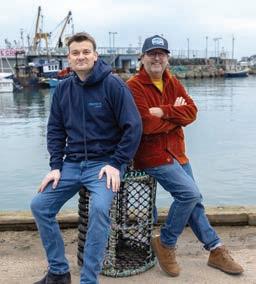
challenges. One of the primary concerns is managing the density of deployed pots to avoid potential negative impacts on marine ecosystems. Unregulated or excessive potting could, over time, alter the balance of reef-building organisms and other species that rely on these habitats. There is also the need to integrate the new method carefully with existing fisheries, ensuring that it does not disrupt the capture of other commercially important species such as crabs and lobsters. In some cases, the design modifications necessary to optimise scallop retention in pots may inadvertently reduce the catch rates of these other species. Further research is therefore essential to refine pot designs, optimise light configurations—including the intensity, colour, and flashing patterns of the LEDs—and determine the best operational practices to maximise benefits while minimising any trade-offs.
As interest in sustainable seafood continues to grow, the future of scallop potting appears bright. There is increasing support from governments and environmental organisations for methods that reduce the environmental footprint of fishing operations. Incentives, subsidies, and policy measures are likely to further encourage the adoption of lowimpact fishing practices, including the use of LED-lit pots for scallop harvesting. The method also holds promise for expanding fishing opportunities in areas that are currently off-limits to mobile gears like dredges, such as offshore wind farm sites and other environmentally sensitive regions. By offering a sustainable alternative that aligns with global conservation efforts, scallop potting with lights has the potential to reshape the scallop industry on an international scale.
Innovation can support more responsible fishing practices
The implications of this technological breakthrough extend beyond the immediate benefits of improved sustainability and economic opportunity. It represents a shift in how the seafood industry
approaches resource management and environmental stewardship. Traditional fishing methods are being challenged by innovative practices that harmonise production with conservation. The development of Disco Scallops is a clear example of how technological innovation can lead to more responsible and efficient use of
marine resources, thereby contributing to the broader goals of responsible consumption and production, climate action, and the protection of life below water. With ongoing research and development, as well as supportive policy frameworks, the future of scallop fishing looks set to embrace a more sustainable and responsible
model—one that benefits both the environment and the people who depend on it for their livelihoods. As consumers increasingly demand ethically sourced and environmentally friendly seafood, the rise of Disco Scallops signals the importance of innovation in developing fishing methods that acknowledge these concerns.
Ukraine’s fisheries and aquaculture sector: Impacts of Russia’s war against Ukraine
Implementing state policy regarding food security, particularly in the field of fisheries and the fishing industry, protection, use, and reproduction of aquatic bioresources, regulation of fishing are among the major tasks of the State Agency for the Development of Melioration, Fisheries and Food Programmes (hereinafter “the Agency”) under the Ministry of Agrarian Policy and Food of Ukraine.
During three years of war, Ukraine’s fisheries management has faced setback after setback. But under skilled management, the government bodies responsible for fisheries have continued to implement legislation to keep moving the sector forward. Production and employment may be down temporarily, but modernisation remains a government and industry priority.
This is the 11th in a series of articles for Eurofish Magazine about the operation and survival of the seafood sector in Ukraine during the war.
Before the full-scale invasion, Ukraine had a strong domestic supply of animal proteins—meat, poultry, and fish—largely meeting national demand. The country was one of the largest poultry producers in Europe, with chicken being the most consumed meat due to its affordability. Beef and pork were produced domestically, though pork was more common. Small-scale farms and large agribusinesses ensured a steady supply. Domestic fish production is less developed, with significant reliance on imports, especially for seafood. Freshwater fish from aquaculture and natural water bodies covered part of
the demand. Supermarkets and markets were well-stocked, and prices were relatively stable, with regional variations depending on purchasing power. The onset of the war, however, disrupted livestock farming, fish production, and distribution networks, leading to higher prices and localised shortages of animal proteins, as well as other food shortages.
The war has ended saltwater fishing and destroyed much of the fish farming sector
Russia’s military aggression and the introduction of martial law in Ukraine have had a severe
negative impact on the fisheries sector, affecting all its key areas. In 2022, Ukrainian fishing operations in the Azov and Black Seas were almost completely halted. The catches in Ukraine’s inland waters, coastal marine waters, and exclusive economic zone decreased by 67, with a total catch of 10,052 tonnes compared to 30,480 tonnes in 2021.
The war has also devastated the aquaculture sector, with fish farms across Ukraine suffering significant damage. Combat zones have seen the destruction of ponds, hydraulic structures, processing facilities, and equipment, along with fish mortality and
contamination of breeding sites. Some areas have been mined, making access and operations impossible. The Dnieper Sturgeon Experimental Production Plant, which specialised in breeding rare and valuable sturgeon species, was destroyed, setting back efforts to restore these populations by decades.
The war has also severely disrupted trade infrastructure, supply chains, and market access, particularly in areas close to active combat. Constant shelling has damaged food markets and supply networks, making the distribution of fishery products logistically difficult and

dangerous. Delivering food to these regions poses serious risks to transport workers‘ lives. About half the workforce involved in the fisheries and aquaculture sector has either been drafted into the army or fled abroad.
To mitigate the impact of the war, the government of Ukraine has introduced support measures for agriculture, including the fisheries sector, as regulated by the Law of Ukraine on State Support for Agriculture. This legislation provides financial assistance to producers engaged in breeding, keeping, growing, or harvesting freshwater and marine fish, frogs, invertebrates, algae, and other aquatic organisms. State support is offered through partial compensation of up to 30 of expenses (subject
On the Kaniv Reservoir in Kyiv Oblast, vessels engaged in commercial fishing are only allowed on the water during daylight hours, outside the curfew, and must remain at least 100 meters away from critical infrastructure. In the event of an air raid alert, all vessels must move as far away as possible from critical infrastructure, and crew members should evacuate to the nearest shore shelter whenever possible.
the increase was 27 over 2022, amounting to 18,621 tonnes. The growth of farmed fish production can be partially attributed to the improvements of the reporting system that was disrupted in 2022.
The war’s double-edged
to the limitations specified in the law) and subsidies based on production volume or the size of the water body used.
Agricultural producers can receive up to 50 reimbursement, and agricultural cooperatives up to 70 reimbursement for the construction and renovation of livestock farms, poultry facilities, fish farms, apiaries, milking parlours, processing and storage facilities for agricultural products and animal by-products. The support also covers the purchase of machinery, equipment, and technology for agricultural production and processing.
To ensure safety measures on water bodies, the State Border Guard Service of Ukraine banned fishing in the Black Sea from the first day of the war, 24 February 2022. Additionally, fishing in inland waters has been restricted.
Despite the challenges and thanks to the governmental support, Ukraine’s food sector has remained relatively strong, and efforts to restore meat and fish production are ongoing. Already in 2023, Ukraine’s domestic food security, particularly in the meat, poultry, and fish sectors, showed signs of resilience and adaptation amidst ongoing challenges. According to the national statistics, the combined meat and poultry consumption in 2023 reached 54.7 kg per capita, while the fish consumption reached 13.7 kg, showing a slight increase compared to pre-war times. And then, in 2024, the volumes of capture fisheries registered an 18 growth compared to 2022, reaching 11,883 tonnes, while for aquaculture,
Illegal, unreported, and unregulated (IUU) fishing represents a problem in many countries around the globe, and Ukraine is no exception. However, the beginning of full-scale war had a double-edged effect on the problem. On the one hand, it has complicated monitoring and control in the sector and created conditions for increased poaching, but on the other hand, the male civilian population has decreased due to conscription into the Armed Forces of Ukraine (ZSU), and so has the number of poachers. Though illegal fishing has shrunk over the past three years, the problem persists.
The Agency is actively implementing measures to combat IUU fishing. Efforts include enhancing the efficiency of fisheries inspectors, conducting fisheries protection raids, and monitoring trading
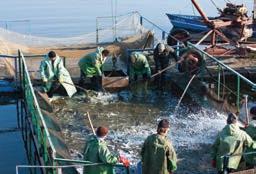
for restocking.
platforms. During fisheries protection patrols on Ukraine’s water bodies, patrol inspectors work alongside representatives of territorial recruitment and social support centres (military commissariats). When individuals of conscription age are found violating regulations, measures are taken to send them for a military medical examination, followed by deployment to training grounds and military units for the defence of the country.
Implementation of modern technologies and innovations also helps to combat IUU fishing and, besides, increases traceability, transparency, and safeguards resource protection. To ensure the proper functioning of the fisheries sector, legislative reforms are being actively developed. In June 2023, the government passed Law No. 7616, which introduces modern governance and digitalisation by implementing electronic fishing declarations and traceability mechanisms, mandating remote monitoring systems on all fishing vessels, regulating fish reception points for accurate catch reporting, and simplifying aquaculture leasing procedures, among other improvements.
In October 2023, the Unified State Electronic Fisheries Management System (eFish) was introduced to track vessel movements, ensure resource protection and transparency while combatting illegal fishing and corruption. This accelerated digitalisation, reduced bureaucracy, and allowed fisheries businesses to access permits and services online for free.
A similar system, ePond, was introduced for the farming sector.
Developed by the Ministry of Agrarian Policy, the Agency, and the Ministry of Digital Transformation, with support from USAID/UK Aid TAPAS and BRDO, these initiatives mark a major step toward sustainable and transparent fisheries management. The Agency continues to advance new technologies to align Ukraine’s fisheries with international standards.
Ukraine actively collaborates with international organisations and neighbouring EU countries to enhance fisheries management and implement innovative global technologies. A key partner is the Food and Agriculture Organization of the United Nations (FAO), with which the State Fisheries Agency cooperates on projects such as the “Comprehensive, competitive, and economically efficient creation of value chains in agriculture, fisheries, and forestry”. This initiative supports modern fishing equipment procurement, grants for Ukrainian aquafarmers, and the digitalisation of the sector.
Ukraine is also involved in the Dniester River Basin Commission, working with Moldova to monitor water levels and temperature during fish spawning, assess ecological flow requirements, and regulate water reservoir management in both countries. Additionally, joint conservation efforts with Romania focus on protecting fish stocks in the Danube Delta and the Black Sea, including discussions on fishing bans, seasonal restrictions, and regulation of Black Sea fisheries.

Given the challenges introduced by the invasion, international support from global partners, investors, and organisations is crucial for Ukraine both now and in the post-war recovery period. Financial assistance is essential for rebuilding damaged infrastructure in war-affected areas. Additionally, the sector requires fishing gear, aquaculture equipment, and quality feed to restore operations. Modernising Ukraine’s fisheries sector depends on access to advanced technologies, including resource restoration, sustainable fisheries management, and improved monitoring systems. Investment in
water quality control equipment, genetic research laboratories, and fish disease diagnostics is critical for ensuring fish health and sustainable aquaculture practices. Continued support from partners, investors, and organisations remains vital for Ukraine’s fisheries sector, both during the ongoing crisis and in the post-war reconstruction phase.
Oleksii Noharev
Deputy director of the Agency’s Department for the Organization of Aquatic Bioresource Utilisation, Aquaculture, and Scientific Support nogarev@gmail.com Aleksandra Petersen, Eurofish aleksandra@eurofish.dk
Neither environmental, economic, nor social considerations can be neglected
Rosa Chapela, head of the fisheries socioeconomics department in CETMAR (Centro Tecnológico del Mar) since 2002, was appointed managing director in October 2024. Ms Chapela has a PhD in law, a postgraduate degree in fisheries economics, and has years of experience in participatory local development, female empowerment, fisheries policy, and aquaculture governance. Here she describes some of the issues facing the Spanish fisheries sector and discusses ways of addressing them.
As a social scientist what are the main challenges you see currently facing the fisheries sector in Spain? How do you anticipate they will evolve over the next decade and what needs to be done to solve these issues?
We could categorise them into three main areas: environmental sustainability, socio-economic viability of sheries, and sheries governance and management. In Spain, the biggest challenge is generational renewal, which is closely linked to the sector’s social and economic viability. Measures for relief are already implemented, otherwise, it will continue to worsen, signi cantly impacting our coastal communities, which are highly dependent on sh and shell sh capture, and aquaculture activities. Spanish authorities are proposing measures to address this critical challenge, such as incentives to encourage participation by young people and women through training, improved working conditions, and access to nancing. Additionally, economic diversi cation measures are being promoted in shing communities, particularly through Fisheries Local Action Groups (FLAGs) and Community-Led Local Development (CLLD) initiatives.
Climate change and environmental sustainability are also major challenges for the future of sheries. While EU policies continue to drive improvement in sheries
management, shortcomings persist across various sheries and ecosystems in European regions. Each region presents diverse characteristics that require urgent climate change mitigation and adaptation measures. Many of these challenges are linked to the goal of decarbonising the sector in the coming years. However, there are still signi cant obstacles to overcome. Another major challenge facing the shing sector must not, however, be forgotten: the decline in sh consumption. In recent years, there has been a signi cant drop in consumption, particularly among young people and middle-aged families. is is an issue because it directly impacts the industry’s core—no consumption means no demand, and both the shing and processing sectors will inevitably su er the consequences.
e average age of shers across Europe is increasing because young people prefer other occupations. What have been the experiences of projects to counter this trend such as those developed by Galician mussel producers and purse seiners? Can these be replicated in other countries?
In fact, generational renewal is at the core of Spanish administrative policies. Initiatives like those in the purse seine and mussel sectors, funded by the EMFAF, aim to engage young people— starting in schools—to showcase
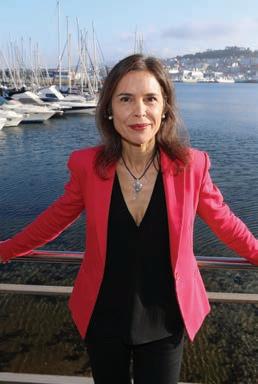
the bene ts of a shing career. It highlights its appeal and the experience of working at sea while contributing to food security and making a living from the ocean. Undoubtedly, these and other initiatives promoted by FLAGs may be replicated in other countries.
Since this is a common European issue, adopting continent-wide solutions is essential. Sharing best practices and success stories across Europe is extremely bene cial. Galicia is a great example, with three training schools for the shing sector and one for
aquaculture, devoted to attracting young people. Additionally, the A Aixola school o ers training in traditional maritime activities, such as wooden boat building, net making, and engine maintenance. is school also attracts many young people, who later nd a job in the maritime industry.
Fisheries managers are enjoined to consider the environmental, economic and social impact of their policies. How, in your opinion, should policymakers respond when there are con icts between these objectives—when, for example, reducing shing pressure bene ts the resource but negatively in uences shers’ livelihoods?
is is a key issue in sheries policy. All sheries managers must strive for a balance among environmental, economic, and social aspects, including the well-being of shing communities. Galicia provides good examples of policies aimed at achieving this balance, as it is highly dependent on sh and shell sh capture, and on aquaculture. Any attempt to reduce shing quotas faces resistance, with arguments based on economic and social data to guarantee that reductions align with the protection of shing communities. Catch reduction measures cause direct and severe impacts on eets and communities, making it crucial for policymakers to rely on up-to-date studies and impact assessments as fundamental arguments to maintain this essential balance.
As director of CETMAR, after leading the sheries socioeconomic unit, you now have a clear view of all the organisation’s work. How would you say CETMAR contributes to regional and national economic development in coastal communities given the range of activities it carries out?
As a public foundation, CETMAR’s core task is to support the development of coastal communities and enhance the competitiveness and sustainability of Galicia’s marine sectors— sheries for n sh and shell sh, aquaculture, seafood processing, and the broader blue economy. e institute has successfully bridged the gap between research, industry, and policymakers, working across all of them to bring innovation and scienti c knowledge to the eld. We act as a link between numerous marine research centres, businesses, and public administration by identifying challenges, fostering new technologies, and leading European projects that attract funding to Galicia. is work is highly collaborative—CETMAR alone could not achieve these goals. Our partnerships with industry, research centres, and policymakers have helped create synergies and a strong cooperation network following the quintuple helix model, which hopefully will continue driving progress in the sectors.
Spain is among the most active countries in the EU in terms of support to women in sheries and aquaculture. What role does CETMAR play in bridging gender gaps and ensuring social inclusion in traditionally male-dominated elds within sheries?
Given that there are numerous women in Galicia working in marine sectors— sh and shellsh capture, aquaculture, seafood processing, and sh sales—CETMAR has been actively involved in projects and working groups to promote the visibility of women and improve their working conditions. We have participated in various national and international projects aimed at empowering women to lead initiatives, quantifying women’s labour, and
addressing data gaps regarding their contributions. Additionally, we have contributed to studies commissioned by DGMARE on the role of women in shing.
Within the European Commission there are voices that feel that concern for the environment is taking precedence over concern for livelihoods. Is this a sentiment that you notice in your work? Do you think that people who express this opinion are justi ed in doing so?
We return to the crucial issue of balancing marine conservation with the economic development of coastal and shing communities. In my work, this concern is less prominent because, from a scienti c and technological transfer perspective, we focus on providing tools to help both policymakers and the sector achieve this balance, ensuring that neither aspect overshadows the other. However, in recent years, the shing sector has expressed frustration with European policies that seem more focused on marine protection than economic viability. It becomes evident in the closure of large marine areas to protect vulnerable habitats, which has restricted access to traditional shing grounds, negatively impacting communities such as Galicia’s hake shers. e sector has called for a more balanced approach, with greater exibility and consideration of the diverse realities of European sheries.
High expectations are pinned on the new Commissioner for Fisheries and his department, now focused on Fisheries and Oceans. Hopefully, considering sheries as a priority sector, his leadership will help strike a better balance between conservation and the protection of the shing industry.
Consumption of sh and seafood in Spain has been falling for some years. is has implications for the health of consumers, but what has been the economic impact on the sheries and aquaculture sector, and what will it take to stop and reverse this development?
is is undoubtedly one of the biggest challenges for the sheries sector and the Spanish food industry, as sh has traditionally been a staple product in Spanish households. e alarming decline in consumption since the post-COVID years is now a priority issue for administration and industry alike. Research institutions notice increased interest from the sector in analysing the causes behind this decline to develop e ective countermeasures. It is crucial to study changing consumption patterns, identify the most a ected age groups, and implement targeted strategies from public authorities and industry stakeholders to reverse the trend.
is matter requires a uni ed response from the entire sheries sector, regardless of shing or farming method, industrial or artisanal nature, or country of origin. e nutritional bene ts of sh are widely recognised by medical and health sciences, and this message should be reinforced by awareness campaigns, especially in schools and among young people. Beyond health bene ts, it is essential to highlight the economic and cultural importance of sheries. e economic viability and future survival of many European coastal communities depend on regular sh consumption. If demand continues to decline, it could threaten the maritime heritage and traditions of shing regions, putting entire shing communities at risk.

6-8 May 2025 *

Seafood Expo Global/Seafood Processing Global * Barcelona, Spain
Tel.: +1 207 8425504 customerservice@divcom.com www.seafoodexpo.com
20-22 May 2025
Aquafuture Spain
Vigo, Spain
Tel.: +34 620 681 861 https://aquafuturespain.com
19-21 August 2025
Aqua Nor Trondheim, Norway post@nor-fishing.no https://aquanor.no/

7-9 October 2025
DanFish International *

10-12 September 2025
Seafood Expo Asia
Singapore
Tel.: +1 207 8425504 sales-asia@seafoodexpo.com www.seafoodexpo.com
Aalborg, Denmark
Tel.: +45 9935 5555 info@akkc.dk https://danfish.com
7-9 October 2025
Conxemar * Vigo, Spain conxemar@conxemar.com https://www.conxemar.com/en/exhibition/






17-19 June 2025
Seagriculture * Rotterdam, Netherlands info@dlg-benelux.com https://seagriculture.eu

22-25 September 2025
Aquaculture Europe * Valencia, Spain eas@aquaeas.eu https://www.aquaeas.org/












9-12 December 2025
AlgaEurope 2025 * Riga, Latvia info@dlg-benelux.com https://algaeurope.org/
* Eurofish will be attending
Publisher Euro sh International Organisation
H.C. Andersens Boulevard 44-46 DK-1553 Copenhagen V Denmark
Tel.: +45 333 777 55, info@euro sh.dk euro sh.dk
Managing editor Marco Frederiksen
Editorial offices Behnan Thomas (bt) H.C. Andersens Boulevard 44-46 DK-1553 Copenhagen V Denmark
Tel.: +45 333 777 64 behnan@euro sh.dk
Dr. Manfred Klinkhardt (mk) Redaktionsbüro Delbrück Franz-Stock-Straße 23 D-33129 Delbrück Germany
Tel.: +49 5250 933416 manfred.klinkhardt@web.de
Technical layout Thomas Jensen
Advertising Aleksandra Petersen Euro sh Magazine
H.C. Andersens Boulevard 44-46 DK-1553 Copenhagen V Denmark
Tel.: +45 333 777 63 aleksandra@euro sh.dk
Frequency 6 issues per year
Circulation 2500 copies
Subscription details Price: EUR 100,–To subscribe send an email to info@euro sh.dk
Unless otherwise stated, the copyright for articles in this magazine is vested in the publisher. Articles may not be reproduced without written permission from the copyright holders. An electronic copy is available on request to Aleksandra Petersen, aleksandra@euro sh.dk
ISSN 1868-5943
Order your free trial info@eurofish.dk




Nobbingmachines andAuto-packers forsardineandmackerel
VredenburgSouthAfrica
Mobile: +27 83 2620362
E-mail: easycancc@gmail.com Website: www.easycan.co.za ONE OF THE MAIN MANUFACTURES OF PROCESSING MACHINES FOR BIG, SMALL AND VERY SMALL PELAGIC FISH

Nobbing down to 110 pcs/kg Filleting down to 100 pcs/kg Up to 450 fish pockets per min
Slånbärsv.4, SE-386 90 Öland Sweden info@seac.se WWW. SEAC.SE
Polystyrene compressors
The specialist in fishbox compactors and recycling
Tel. +45 97371799 runi@runi.dk www.runi.dk

